Disclaimer: This post contains affiliate links to handpicked partners, including tours, gear and booking sites. If you click through or buy something via one of them, I may receive a small commission. This is at no extra cost to you and allows this site to keep running.
Silent Night is the most famous Christmas carol, sung passionately worldwide in over 300 languages and dialects. But did you know the origins and story history of Silent Night Holy Night come from Austria?
It was on Christmas Eve in 1818 that Franz Xaver Gruber first performed the Silent Night song to the lyrics of a poem written by Joseph Mohr in a tiny chapel in Oberndorf, around 20 kilometres from Salzburg city. Now, pockets of the world stand still every year on the very same evening and recite the same message.
A song whose meaning and belief in world peace, the transcending of all boundaries, hope, and unity in ‘all is calm, all is bright’ made it to the UNESCO Intangible Cultural Heritage List in 2011 for its everlasting message.
One that’s as pertinent today as it was during the troubled time in which it was written when the Napoleonic Wars wreaked devastation on Europe for over 20 years and a volcanic eruption in Indonesia in 1815 created catastrophic climate changes that reached Europe, known as “the year without a summer”.
As part of a series of events and locations related to Silent Night (in German: Stille Nacht, Heilige Nacht), you can trace the origins of this eternal song on a journey across three regions of Austria. From its inception to its first printing, to the singing families who carried it across Europe and beyond, you can journey through Upper Austria, SalzburgerLand and Tirol.
Here’s where to find the Silent Night locations in Austria. An Austrian advent ritual with a centuries-long global effect.
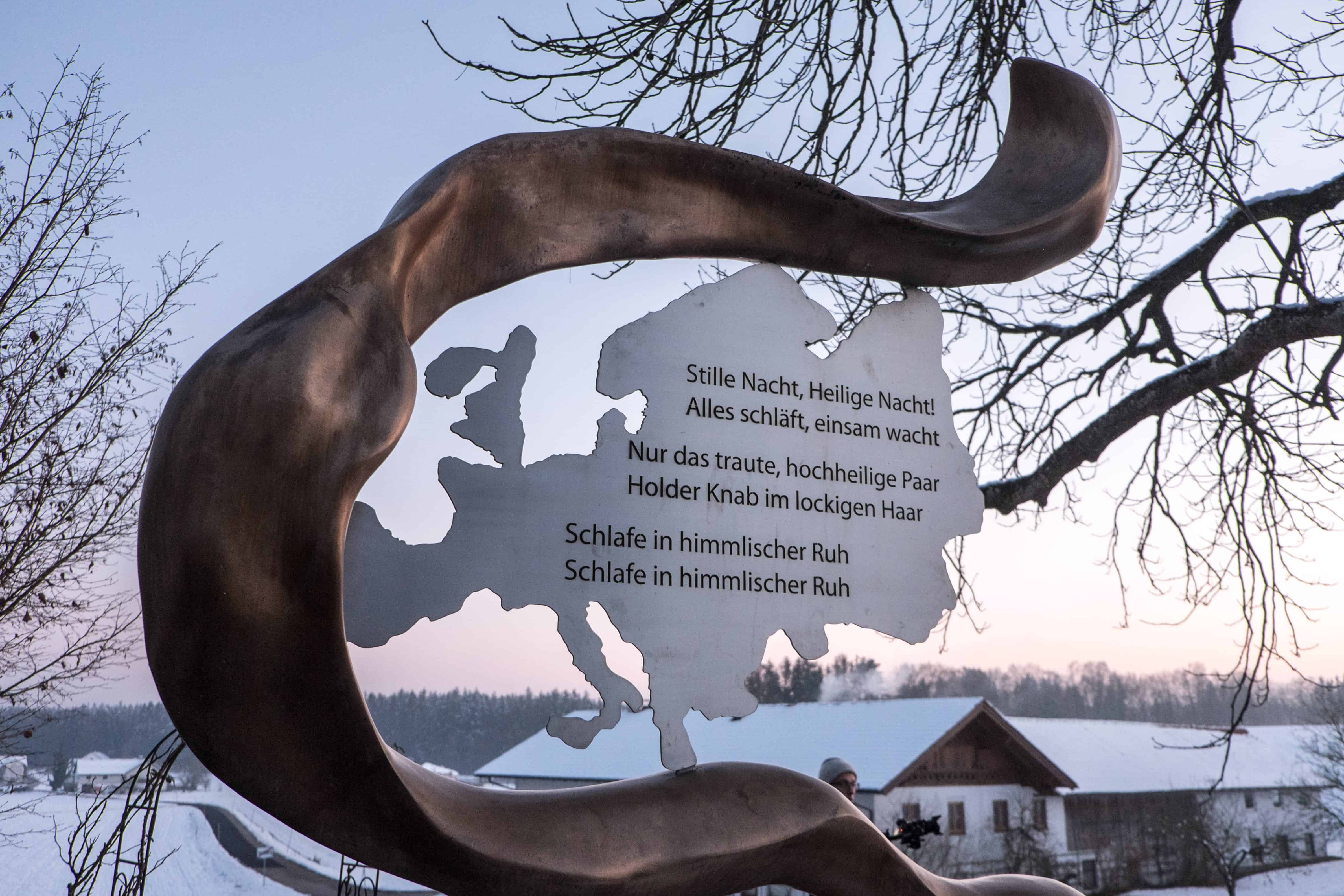
The History of the Silent Night Song in Austria – A 200-Year-Old Story of the Famous Christmas Carol.
Contents
The History of Silent Night in Austria – Song Timeline in Brief
Before setting out to follow the story of Silent Night’s origins in Austria, it’s good to have a timeline of events and locations in mind to follow the song’s journey.
- SalzburgerLand. In 1816 a young assistant priest, Joseph Mohr wrote the text to Silent Night in the form of a poem in Mariapfarr (in SalzburgerLand) where he lived at the time.
- SalzburgerLand. In 1818, just before Christmas, village schoolteacher and organist Franz Xaver Gruber composed the melody for Silent Night at the School House in Arnsdorf.
- SalzburgerLand. Christmas Eve in 1818, Joseph Mohr and Franz Xaver Gruber first performed the Silent Night song at the St Nicholas Parish Church in Oberndorf after mass. It is said that the organ in the church wasn’t working at the time, so the song was written for guitar accompaniment.
- Tirol. By 1819 the song had found its way to the Zillertal in Tirol through organ builder Carl Mauracher from Fügen. He had repaired the Oberndorf church organ, and liking the Silent Night song so much, he took it back home, where it was performed on Christmas Eve in Fügen.
- Tirol. In 1819. The Rainer singing family added their song to their repertoire as singing traders, passing it on to the Strasser Siblings in the Zillertal Valley, thus spreading the song from SalzburgerLand to Tyrol. Before people knew who wrote Silent Night, it was presumed to be a Tyrolean song!
- Upper Austria. Between 1827 and 1832, Joseph Greis published a pamphlet of songs, which included the full Silent Night text (the exact date is unknown). This was seen as the first official circulation of the song text.
- Europe, the US and the World. 1831 onwards. The Strasser Siblings sang Tyrolean songs in 1831 in Leipzig to boost sales at their market stall. One of those was Silent Night. The Strasser Family singers and the Rainer family toured Europe, with the Rainers taking the song to the US in 1839, which began with a performance in New York.
- Today, all around the world, the song is traditionally sung at the end of the Christmas Eve service. Many communities in Salzburg, Upper Austria, Bavaria and Tyrol silence the organ and end the service by singing Silent night in its original German version, “Stille Nacht, Heilige Nacht”, by candlelight.
Silent Night Itinerary – The Christmas Carol Heritage Path in Seven Days
You can comfortably see the main sites that cover the core aspects of the Silent Night song’s history timeline in seven days. It would be easier, logistically, to start eastward in Upper Austria, working westward through SalzburgerLand and to Tirol (or the other way around).
The following overview of Silent Night destinations and highlights is in the chronological order of the song’s beginnings in SalzburgerLand to the journey it took with the Tyrolean singing families.
Origins of Silent Night in Salzburg, SalzburgerLand
Duration: 2-3 days
One of the beating hearts of advent activity is the well-known city of Salzburg where Christmas markets, shows, gorgeous city decor and themed museums get everyone in the Christmas mood. And with the wider region – known as SalzburgerLand – being at the very core of the Silent night song’s origins, it is certainly the very best, and the most traditional place to start.
Where to stay
Base yourself in Salzburg and day trip to the nearby villages. The budget 3* Bergland Hotel in the historical centre of Salzburg or the mid-range Stein Hotel – a legendary establishment on the banks of the Salzach River renovated into an art hotel.
Arnsdorf and Oberndorf
Seven locations form the roots of the song in this area alone, yet two of those mark the very beginnings of the famous Christmas music.
Visit the village of Arnsdorf where Silent Night was first composed. The schoolhouse where Franz Xaver Gruber taught and turned the poem into the melody we know today is a working school on the ground level, and a museum into his life and the song’s subsequent growth on the second floor.
If you have the chance to talk with curator, Max Gurtner it’s a passionate insight into how this village has great pride in the roots of Silent Night as the most popular song of all time. Max even let me play on the church organ that Franz Xaver Gruber once played on, which was a special moment in my discovery of the story.
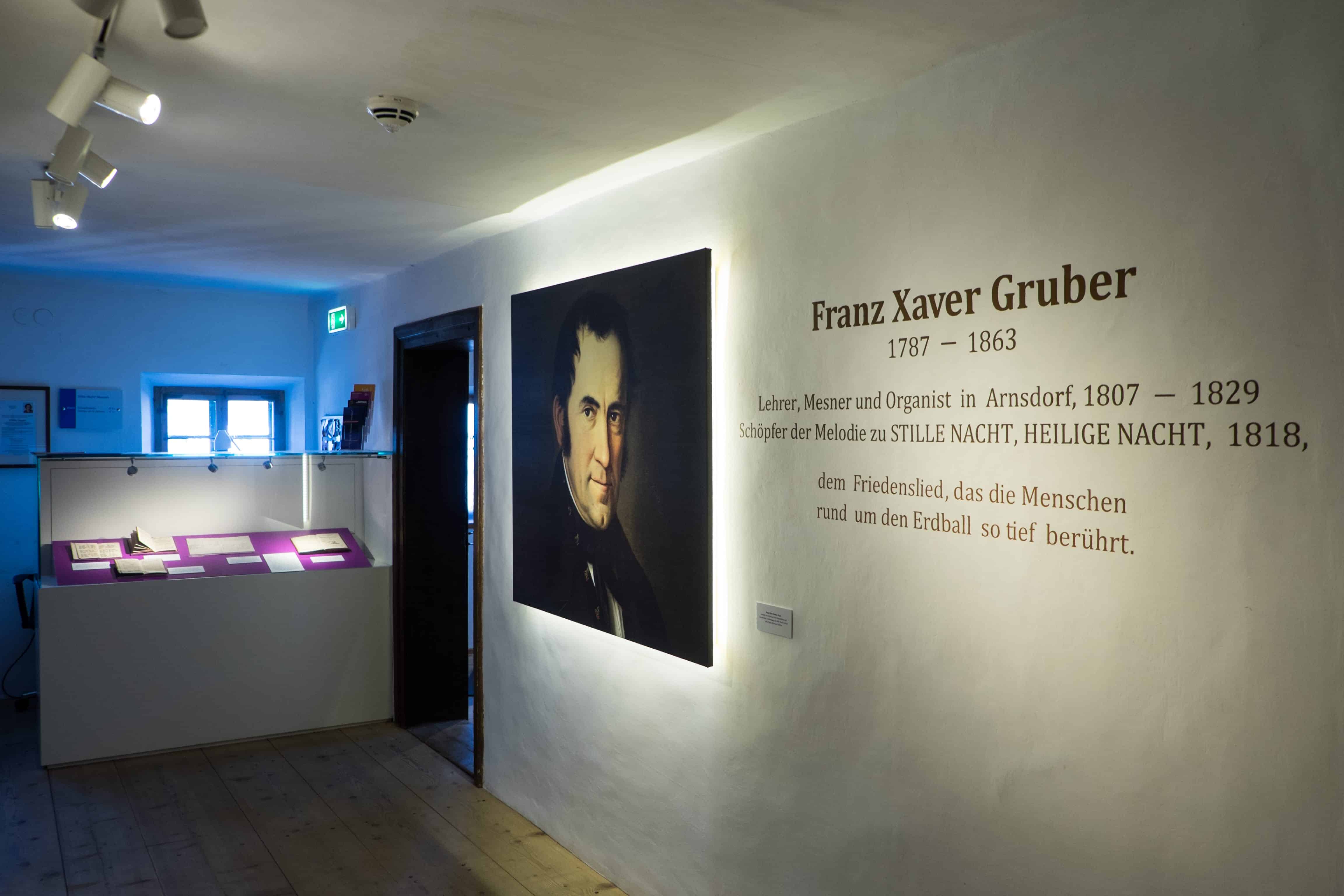
Franz Xaver Gruber School house, Silent Night Museum.

At the Franz Xaver Gruber School in Arnsdorf.
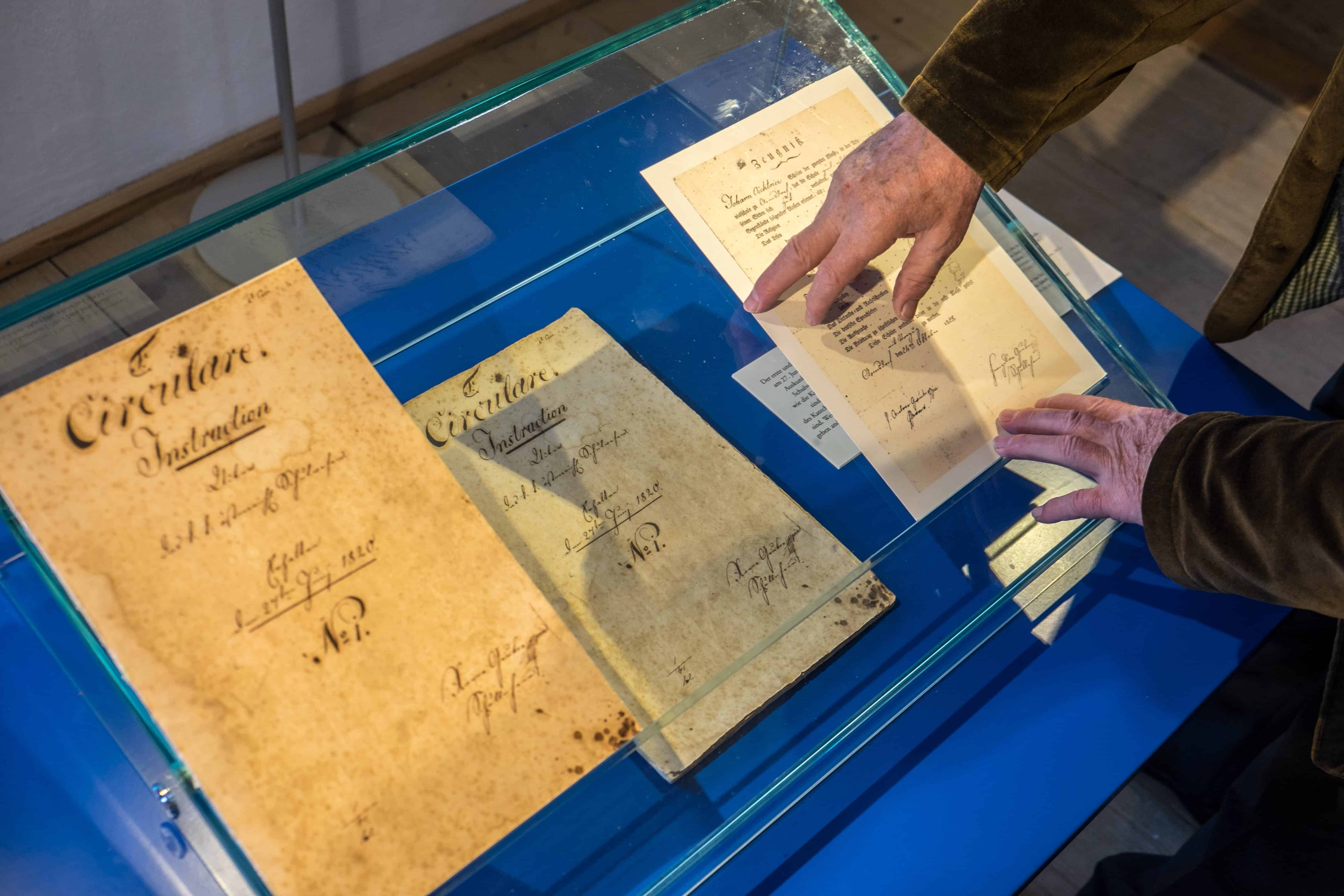
Documents belonging to Franz Xaver Gruber.

Franz Xaver Gruber’s Organ in Arnsdorf Church.
Less than five kilometres from Arnsdorf, visit the Silent Night Chapel in Oberndorf village and the Silent Night Museum.
While the original chapel of St. Nikola on Oberndorf bei Salzburg where Silent Night was first performed no longer stands, you can still feel the presence of how this song would have made such an emotional impact in a tiny space. While living in Arnsdorf, Franz Xaver Gruber took an additional job as organist at the St. Nikola Church, which is where he met Joseph Mohr.
Paintings and plaques commemorate Mohr and Gruber, and you’ll find drawings, photos and timeless posters from over the decades of this very famous chapel all over the region and in other museums related to Silent Night across Austria. Get there early and enjoy a moment of tranquillity, which this song represents.
BOOK: A Silent Night Christmas Eve Tour to Oberndorf from Salzburg. A change to join in the festivities of this famous chapel or this private Silent Night Christmas tour anytime during the advent season.
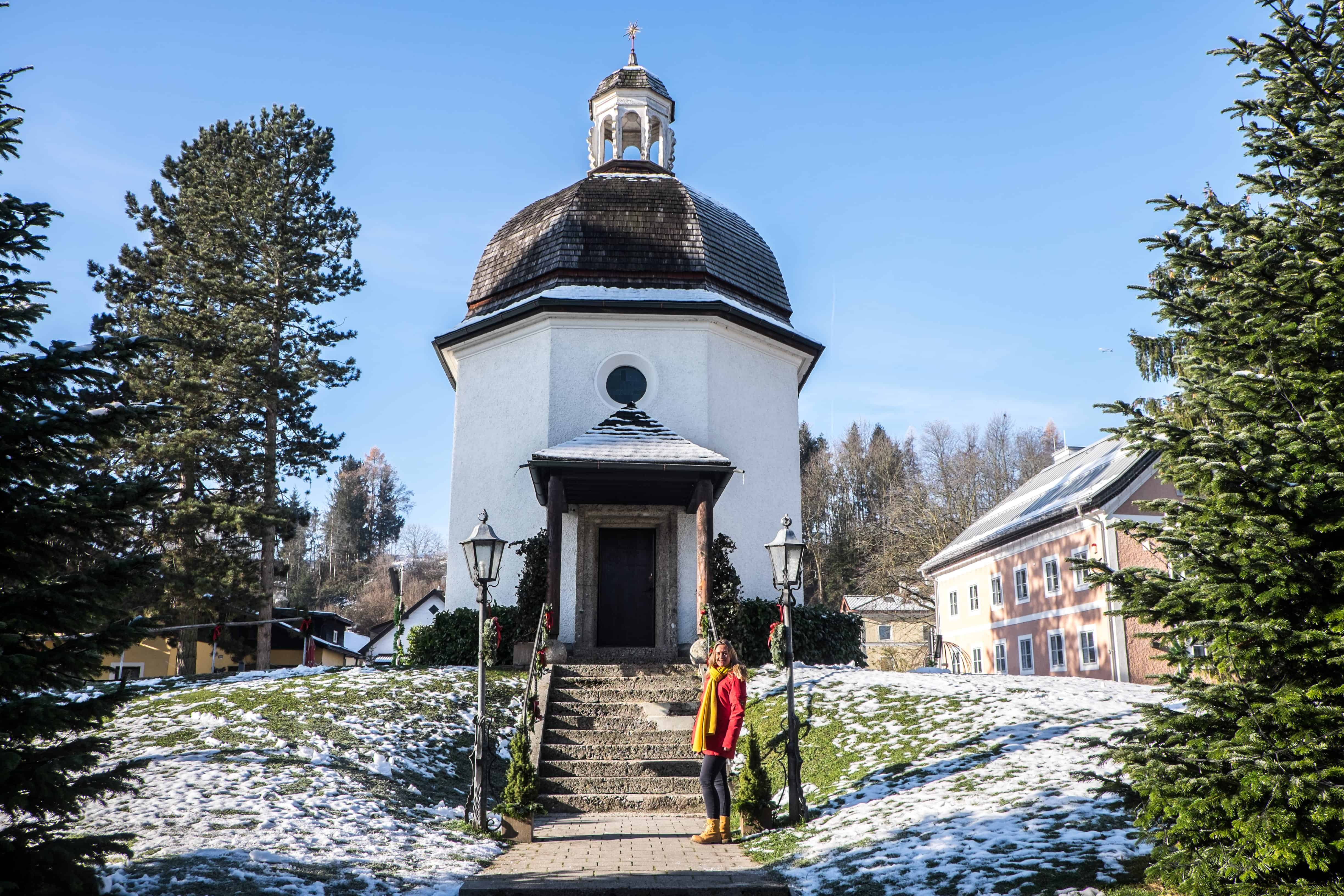
Visit the Silent Night Chapel in Oberndorf, Austria.
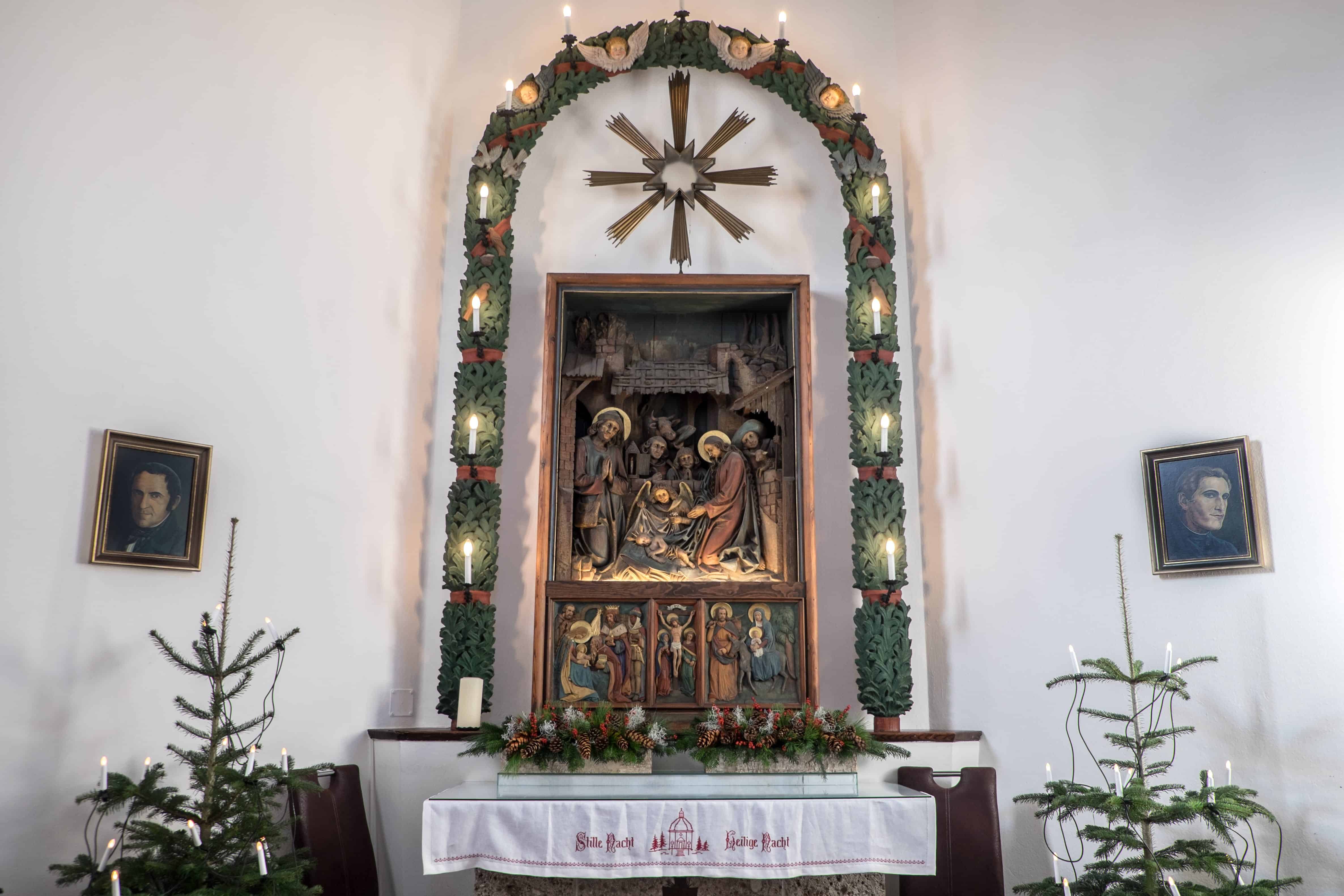
Inside the Silent Night Chapel.
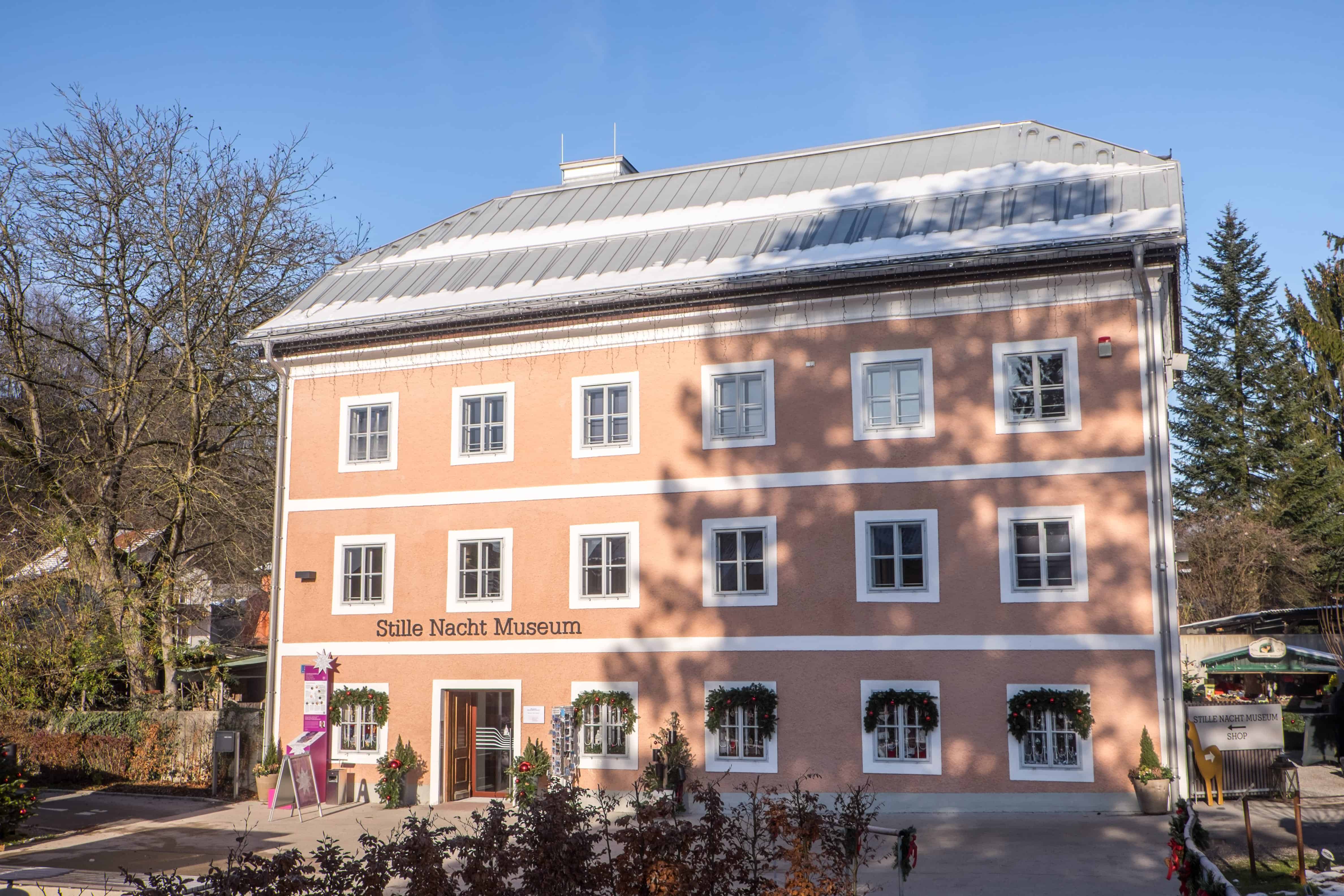
The Silent Night Song Museum, Oberndorf, Austria.
Salzburg – Advent in the City
Salzburg city certainly pays homage to the Silent Night song as the region’s capital. It is a city that loves Christmas and everything associated with it, including this Christmas carol. Advent is very special here and has a reputation for its romantic, advent atmosphere.
I took a guided ‘Silent Night’ Christmas tour with local expert Michaela Muhr at the Salzburger Christkindlmarkt on the Domplatz and Residenzplatz in the very heart of the city.
Every Monday during the advent period, local guides offer tours to retrace the footsteps of Joseph Mohr, who was born in Salzburg, lived at Steingasse 31, and was baptised in the same font as Mozart in the Salzburg Cathedral.
Mohr’s musical education is further connected to the Cathedral and the Lyceum school. Learning about the history around you adds an extra layer to the Christmas Market scenery.
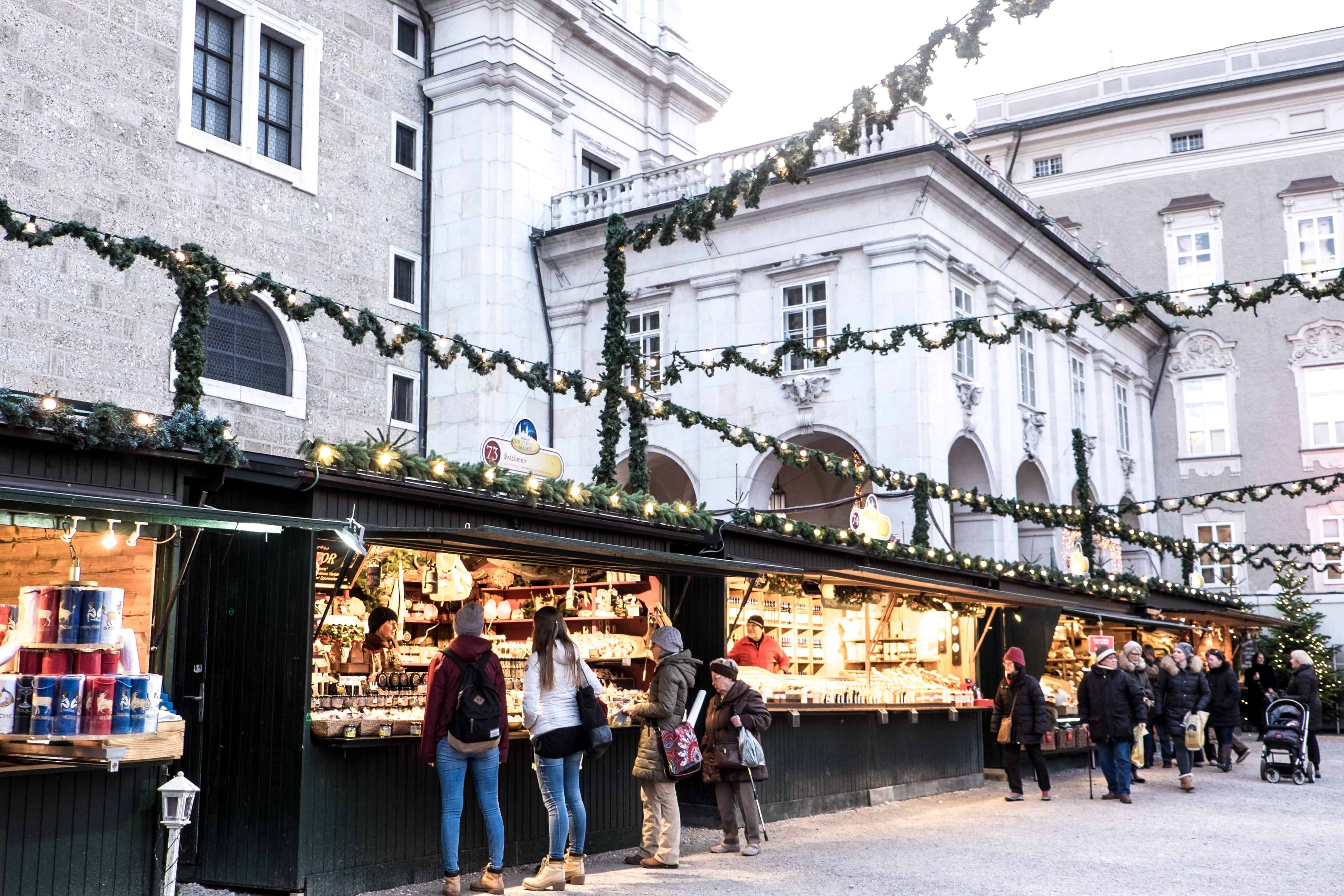
Salzburg Christmas Market.
Over 100 traditional market stalls filled with ornaments and decorations, sweet treats, nativity figurines, and the glorious smell of Glühwein and fruit Punsch lure you in under the trail of sparkling lights that represent the stars. All the while, you are surrounded by the glow of the Cathedral.
Carol singers perform outside every evening, but you will not hear Silent Night until Christmas Eve, and only then, from within.
While there are Christmas markets in Mirabell Square, Sterngarten, Hohensalzburg Fortress, and Hellbrunn (if you want to tour them all), the Salzburger Christkindlmarkt has a special representation. Since 2014, one of the seven Silent Night towns has gifted the tree.
BOOK: Salzburg: Christmas Market historical walking tour. Learn about Salzburg advent traditions and Silent Night origins on this 90-minute walking tour.
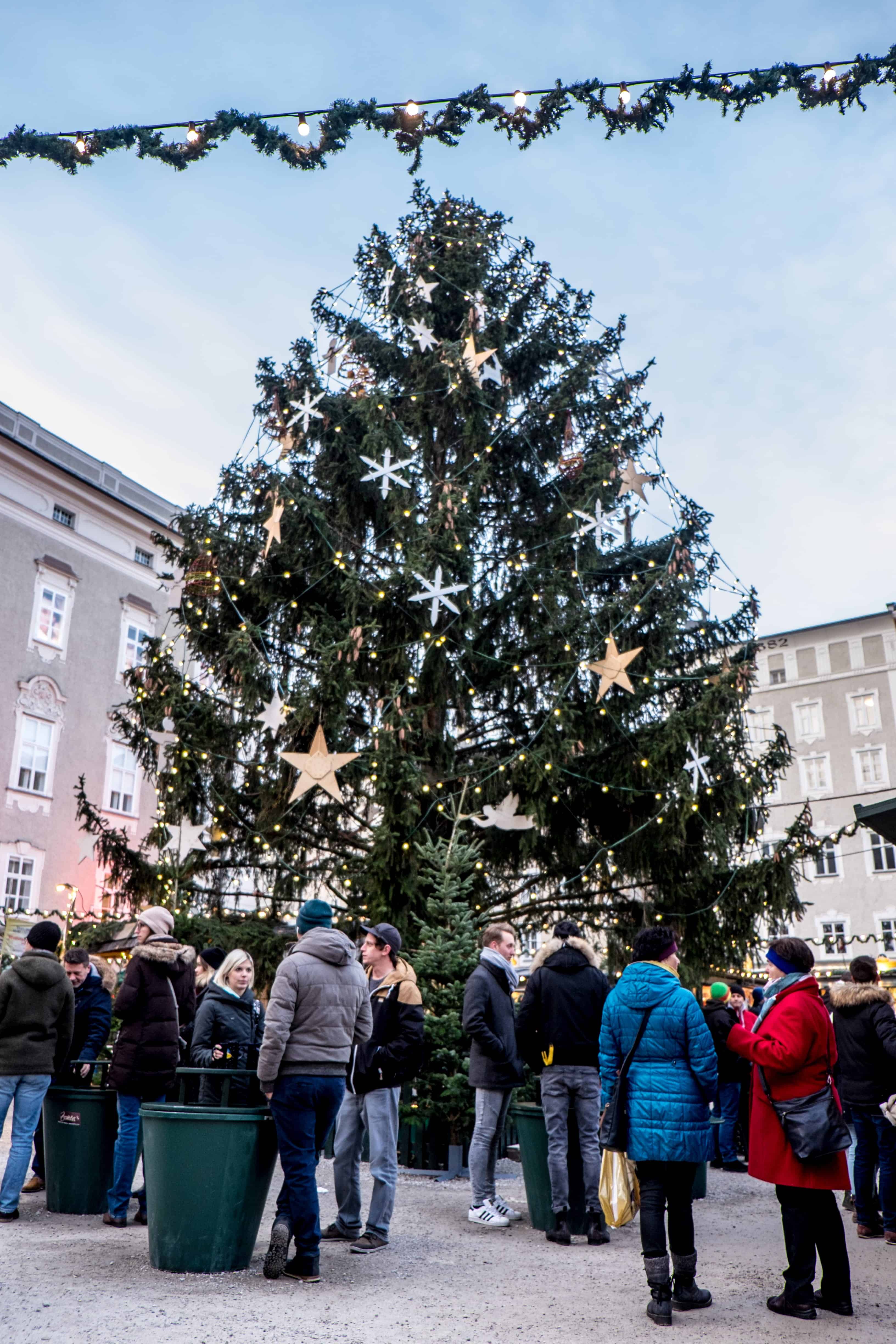
The Christmas Tree in Salzburg Christmas Market, gifted by one of the Silent Night associated villages.
Open all year round, but with the most footfall during the festive period, the Christmas Museum Salzburg on Mozartplatz was a fascinating and incredibly well-curated collection of artefacts from 1840-1940.
Everything from model toys of Krampus and the Christkind to jewellery, tree decorations, delicately designed nativity, and advent cribs fill the room in floor-to-ceiling glass cabinets. You never know how many Christmas related objects existed until this point and how we express advent differently worldwide.
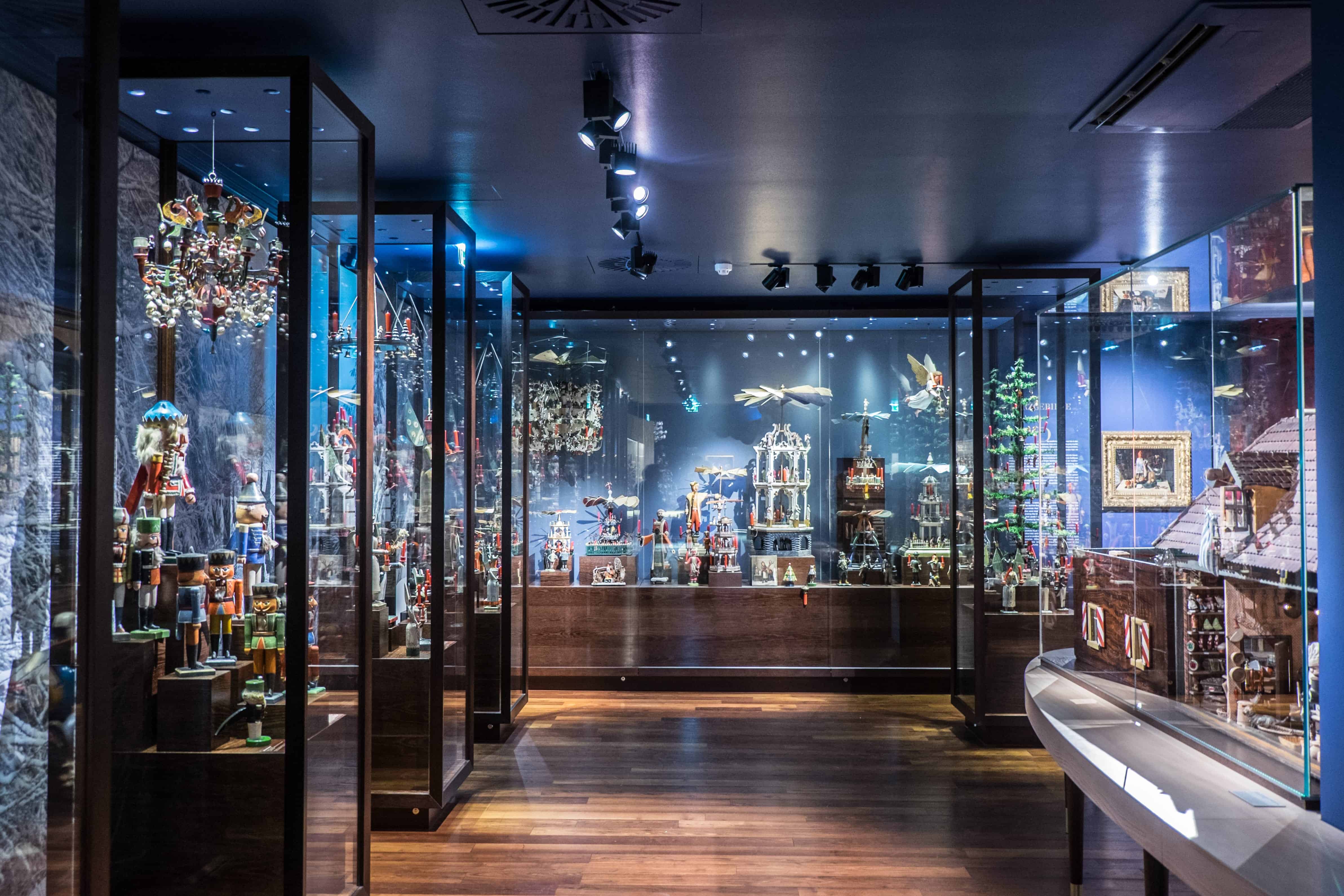
Exhibits at the Christmas Museum in Salzburg, Austria that’s open all-year-round.
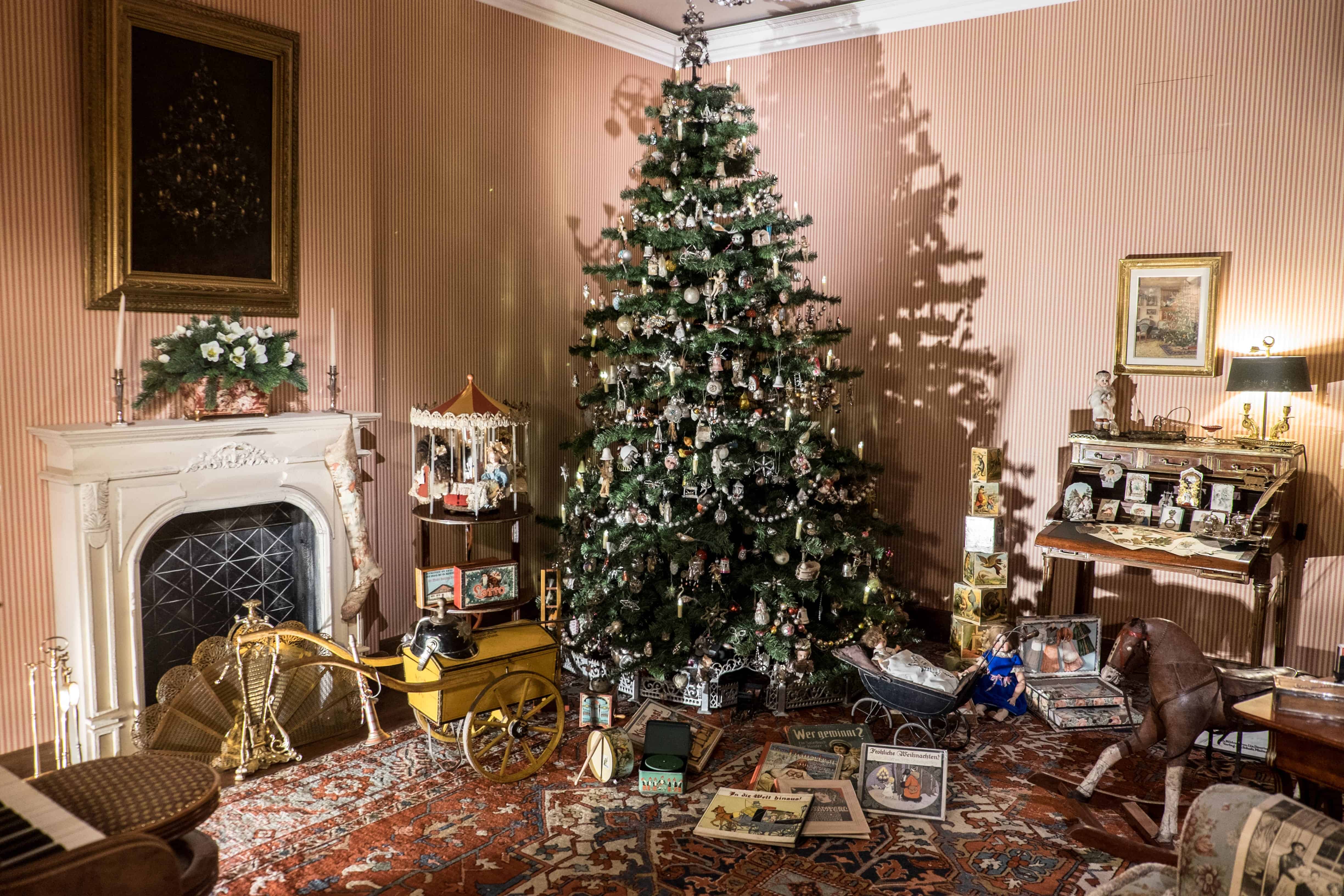
Family Christmas exhibit at Salburg city’s Christmas Museum.
I ended the day attending an evening performance of the new Musical, ‘My Silent Night’ at the Salzburger Felsenreitschule. With its debut on 24 November 2018, this new stage play is a comical and heartwarming mix of messages around the celebration of peace, unity and goodwill with a little Broadway touch.
Told from eight different perspectives and set in Salzburg, this play touches upon some Austrian politics but with an overarching message that can relate to anywhere in the world. With English subtitles projected onto the back wall, this play is accessible to all visitors. You might find yourself wiping a tear or two when Silent Night is performed at the very end, accompanied by a grand orchestra.
READ MORE: Why You Should Visit Salzburg – The Musical Metropolis Beyond Mozart and The Sound of Music.
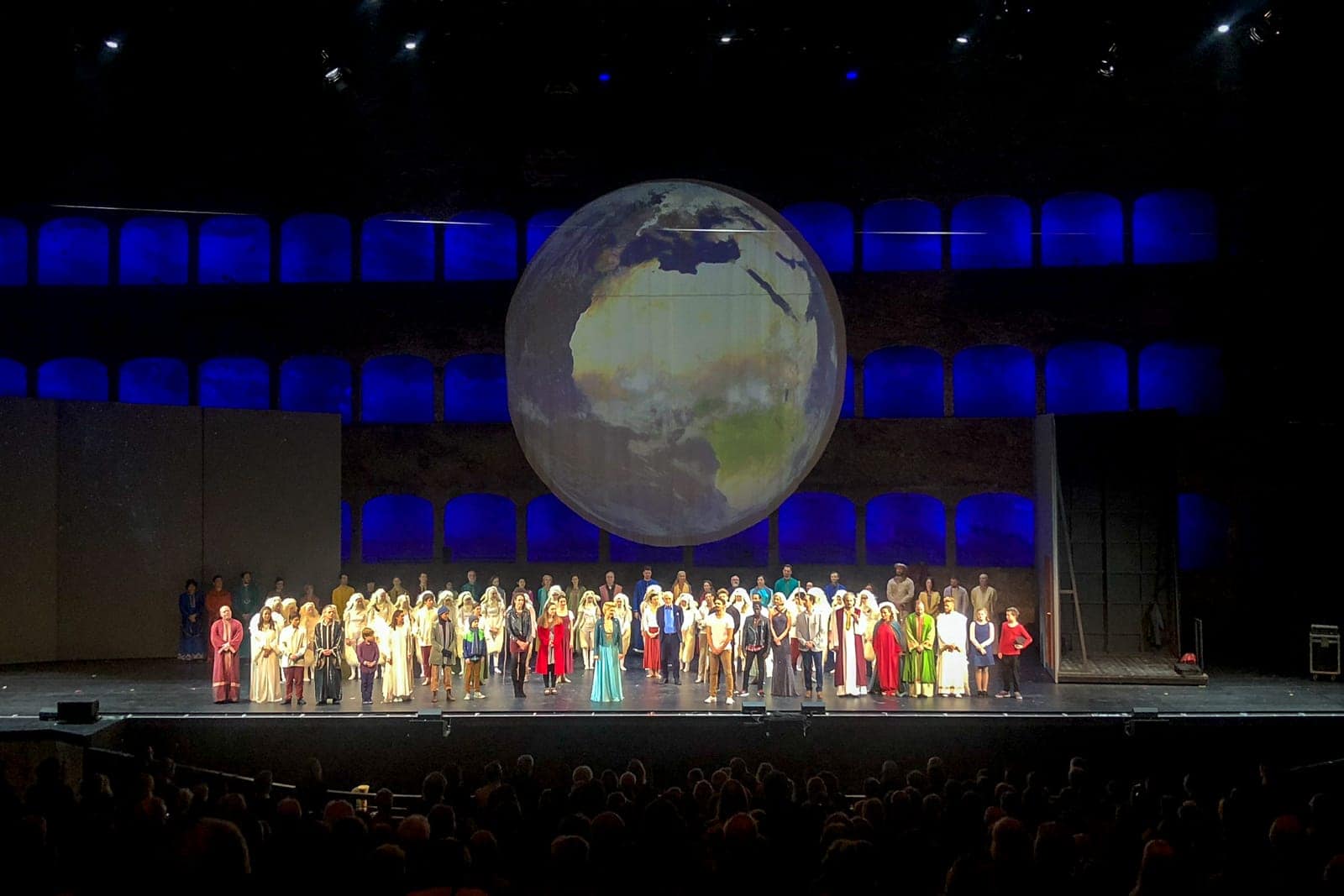
Cast of the Silent Night Musical at the Salzburger Felsenreitschule.
The Trail of Silent Night in Upper Austria
Duration: 2 days
Steyr is the city that lies at the heart of the well-known Christkindl region, and a visit to Upper Austria means not only following the Silent Night trail further but indulging in all things advent and festive.
Where to stay
The Stadthotel Styria, a 400-year-old historic building in the old town of Steyr or Hotel Mader – a 16th-century Renaissance building on the main square.
In Ried im Innkreis, H+ Hotel Reid is a top-rated, modern 4-star property in the town centre.
City of Steyr
The city of Steyr is picture-perfect, with pastel-hued buildings lightly dusted with the first layers of snowfall. The extra layer of advent comes with the traditional Christmas market in the old town, where you can sip on locally brewed Glühwein while being mesmerised by the colourful and intricately detailed facades of the blending late-Gothic, Renaissance and Baroque architecture, some still with their original wooden triangular roofs.
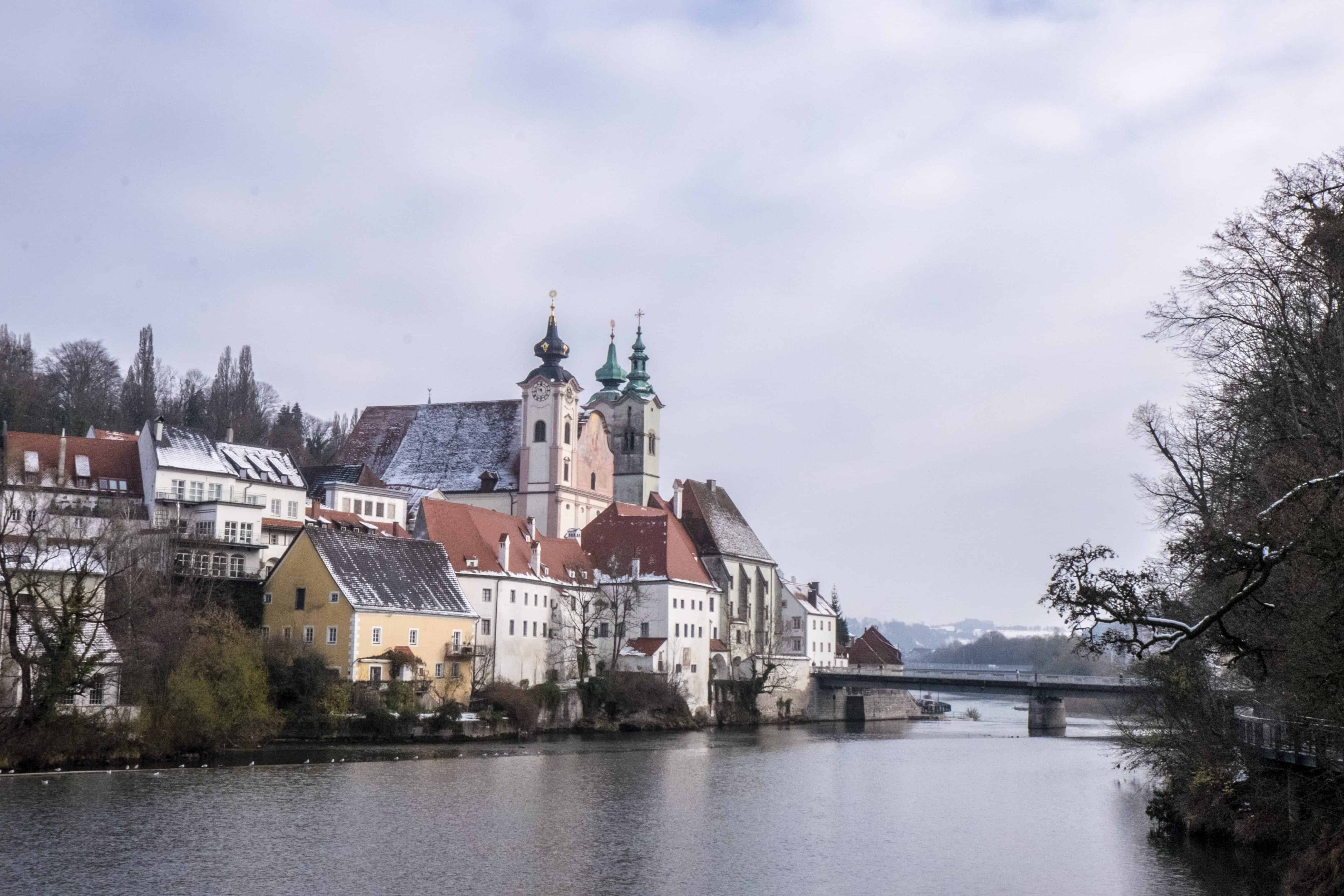
The beautiful city of Steyr in Upper Austria.
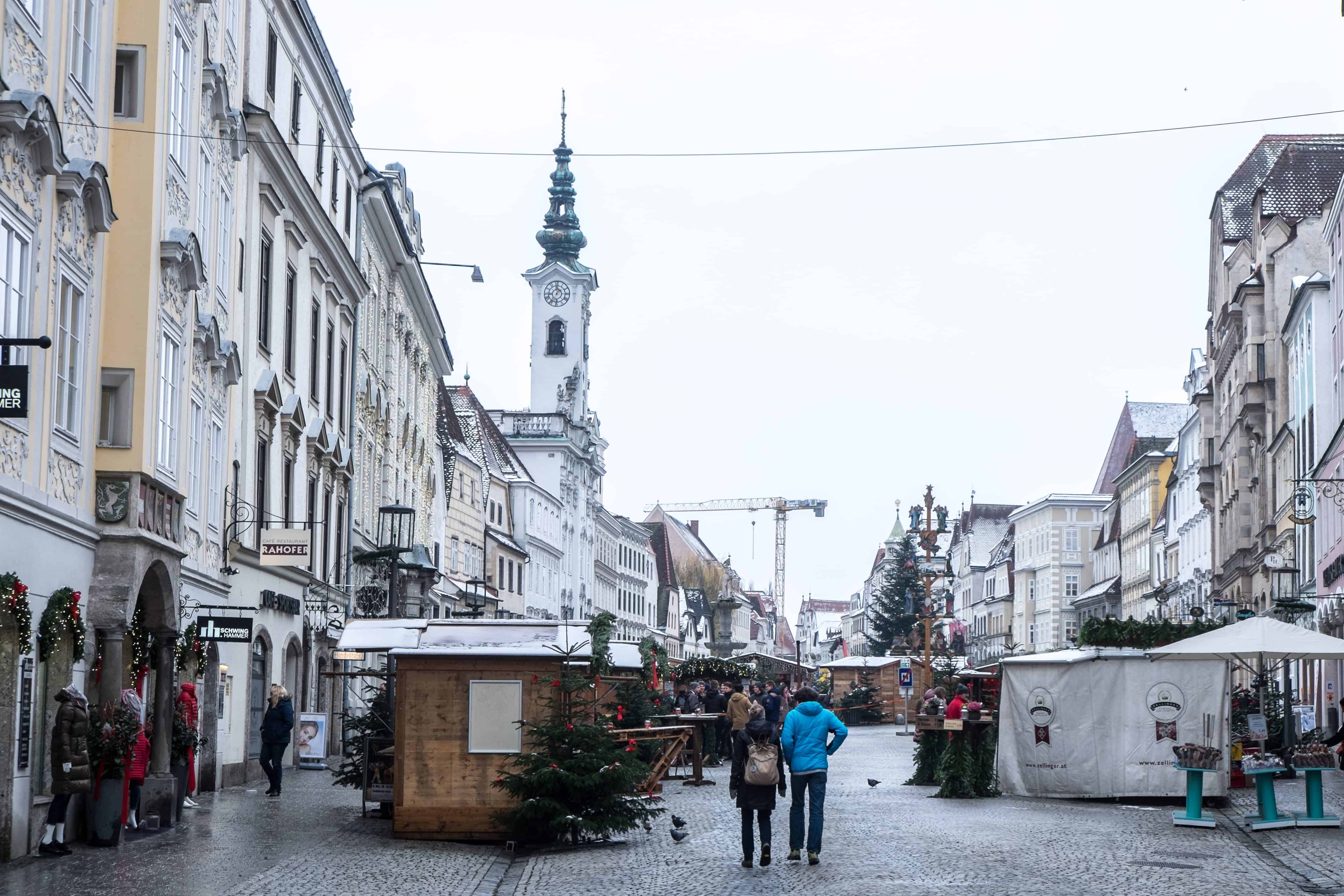
Steyr Christmas Market.
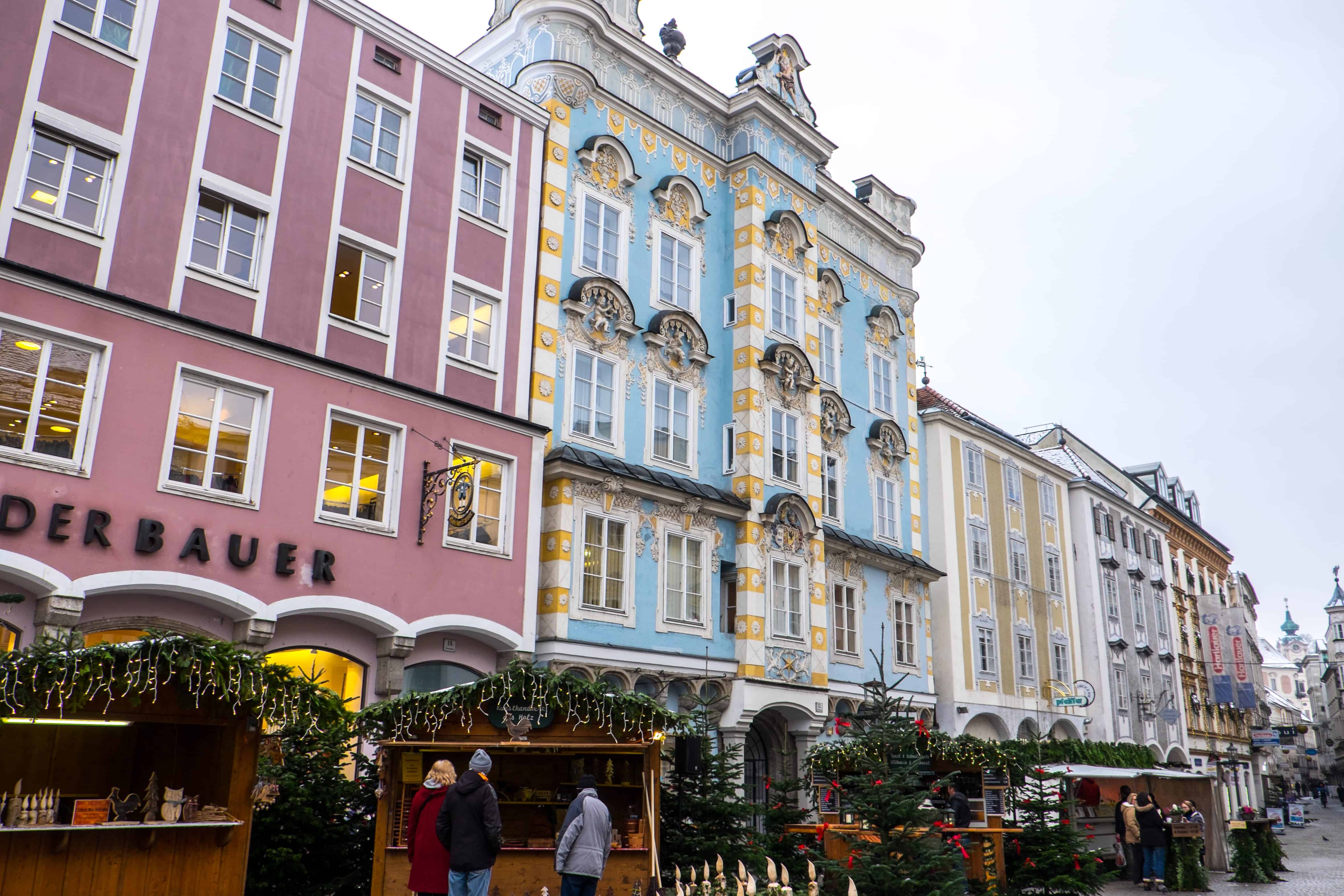
Baroque architecture of Steyr, Austria.
Running through the market area is the main street of Grünmarkt and it is here that you can visit the former printing house of Joseph Greis who produced a songbook in 1928 that first documented Silent Night in written form, and which was multiplied and sold.
The pamphlet, called ‘Four Beautiful New Christmas Carols’, is likely the oldest printed version of the world-famous Christmas song. This wasn’t known as a site relating to Silent Night until 2016 when a pamphlet featuring the song was found at a Viennese antique store, which included its origin: “Steyr, printed and for sale at Joseph Greis”.
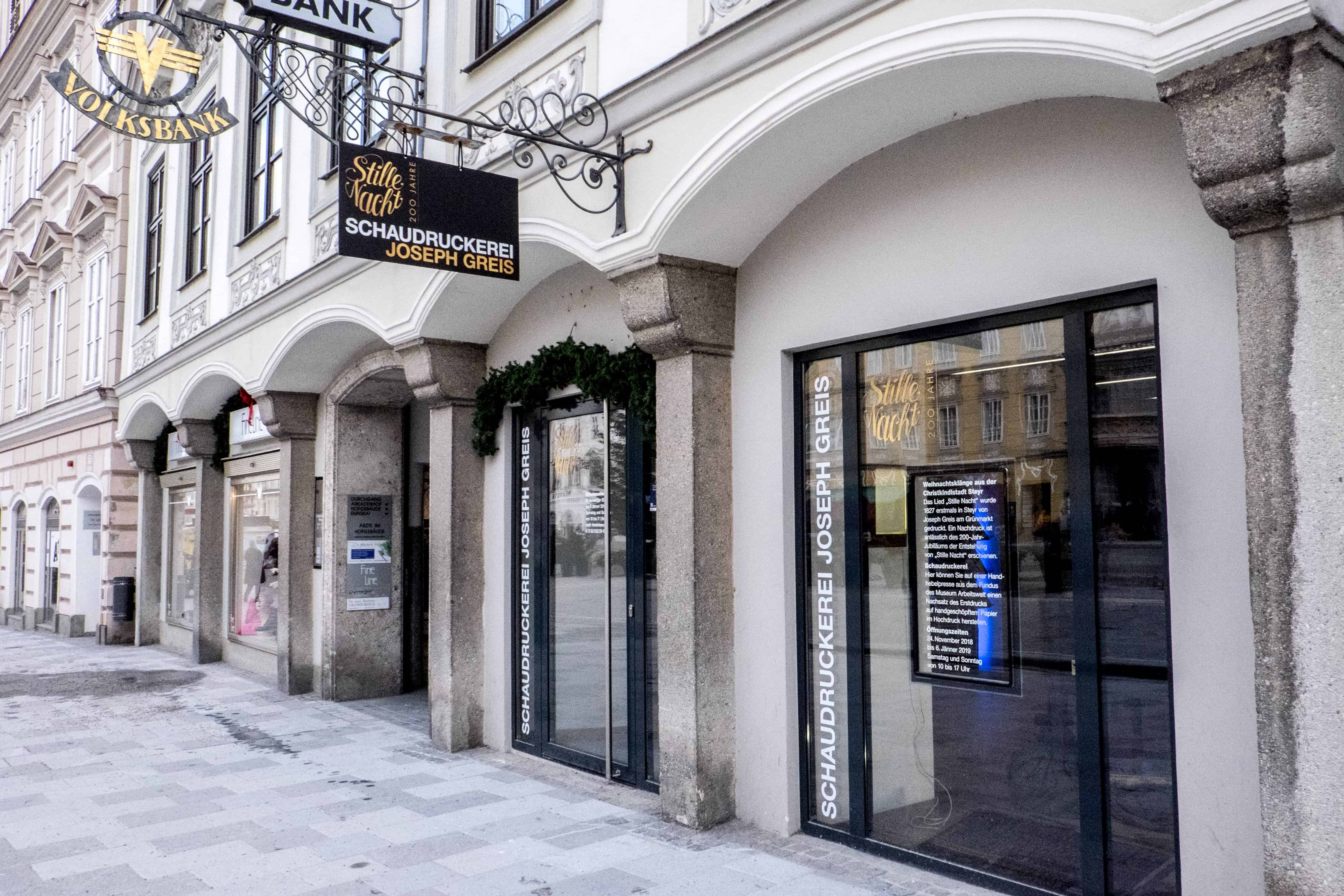
Joseph Greis Printing House in Steyr Austria where the Silent Night text was first printed.
This demonstration print shop is housed in the original site, where you can print your very own copy of Silent Night on the original printing machine dating back to the 19th century. As a digital publisher, I’m still fascinated with the print press, and the earliest forms of machine printers like this are an art form.
My guide, Wolfgang talked me through each process from inking the letters, lining up the paper, pressing with the right pressure and pulling the finished print off like a plaster to reveal my own stamped-in-history masterpiece.
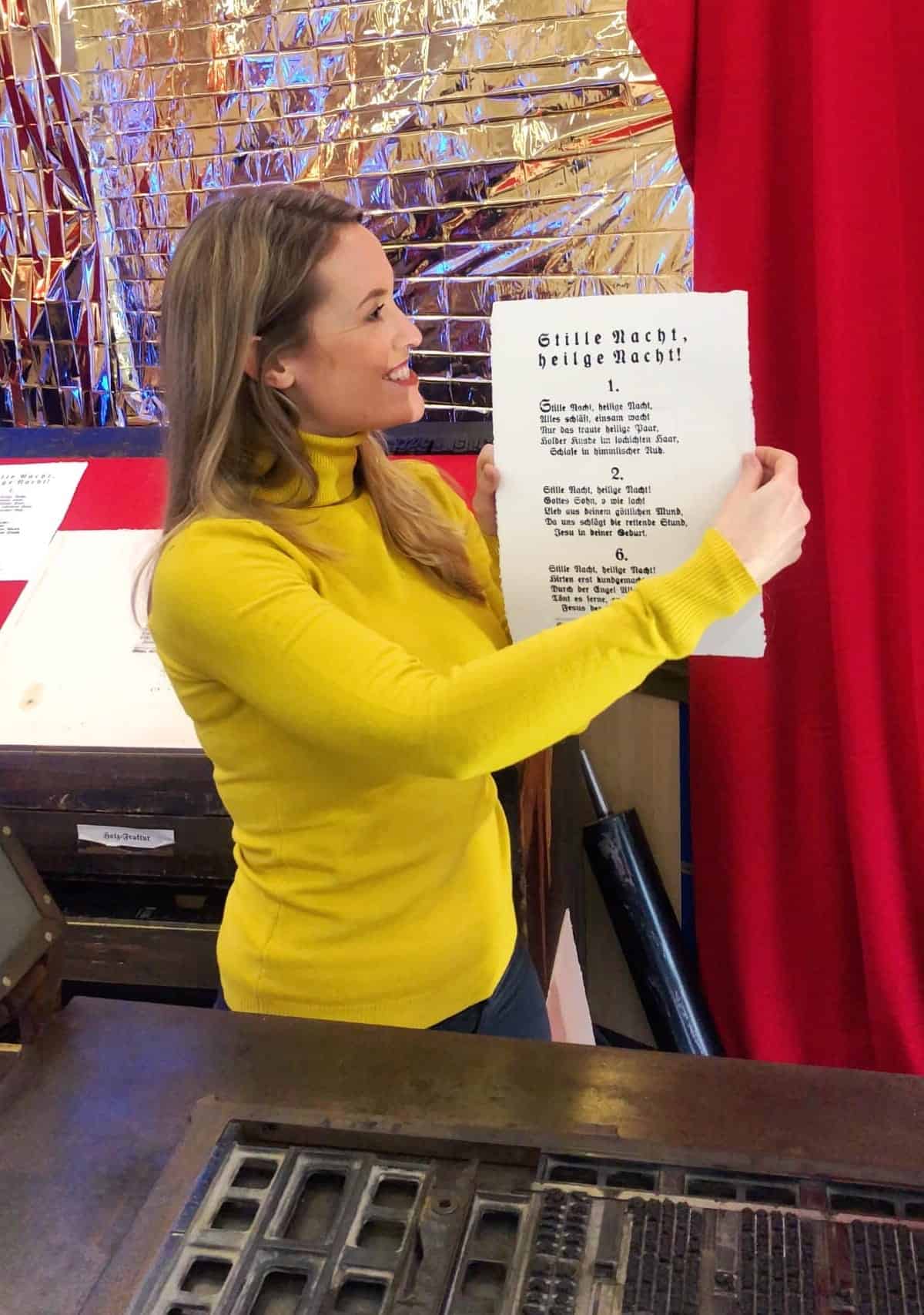
Printing a copy of Silent Night lyrics on the original print machine in Steyr.
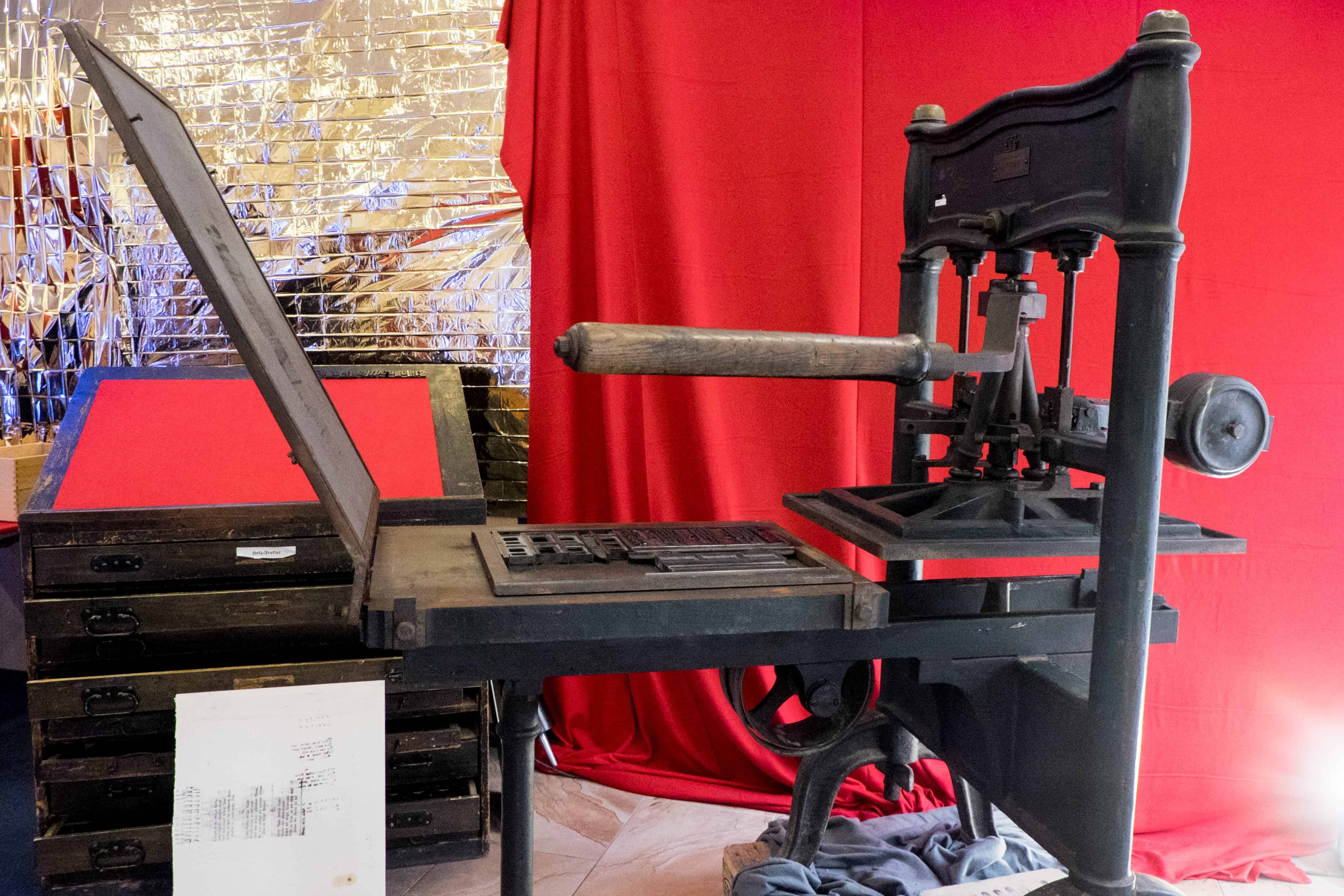
Original Silent Night Print Press.
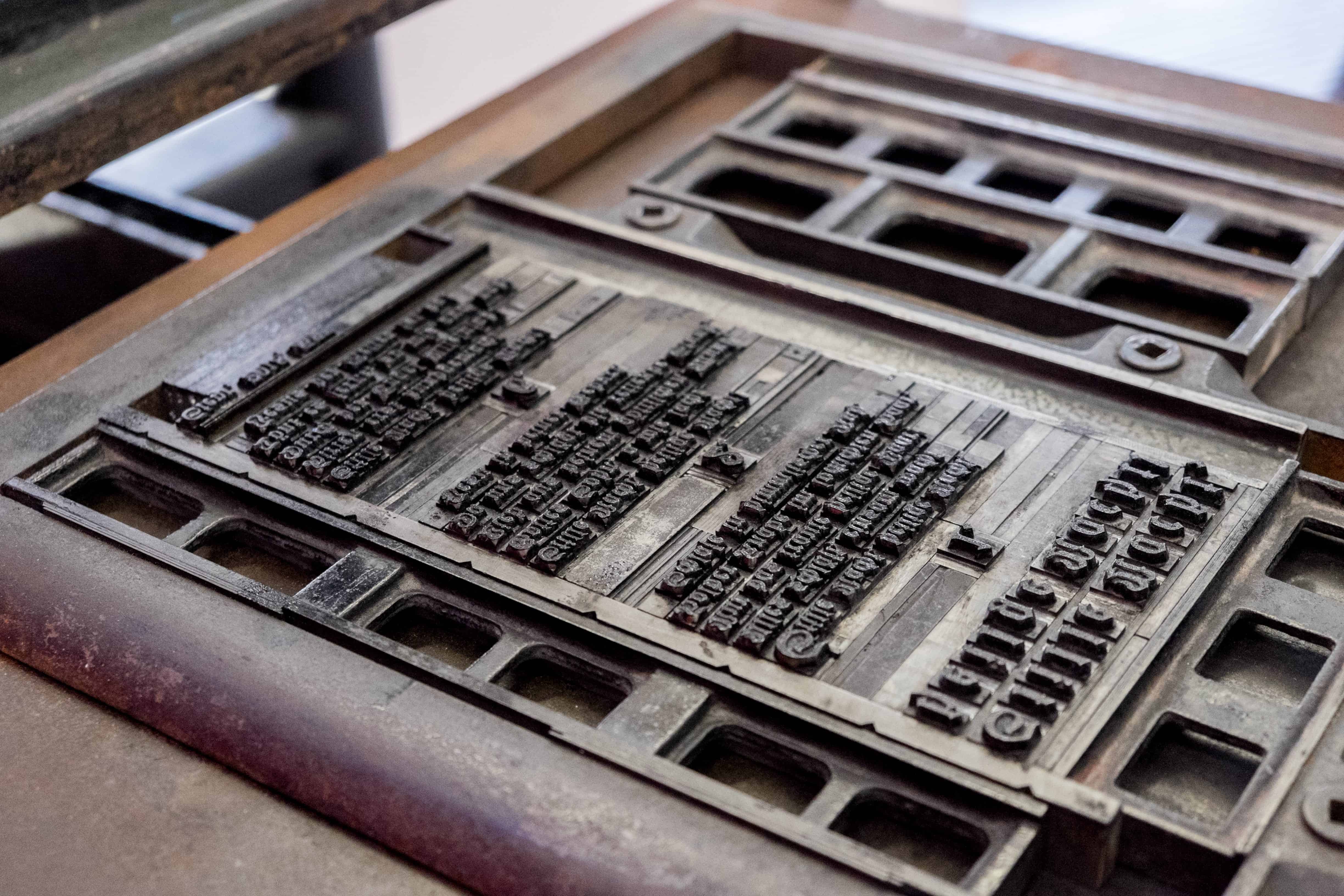
Original Silent Night printing letter blocks.
Since November 2018, the first Austrian Christmas Museum in Steyr has displayed a replica of the first text print of “Silent Night”.
The first Austrian Christmas Museum and train are a must-see during the advent season and features over 14,000 antique Christmas decorations dating from 1830 to 1945 from Elfriede Kreuzberger’s collection, alongside 200 dolls.
The train rides across three floors to what is known as the ‘Angel Workshop’ and is a themed train ride you will never forget.
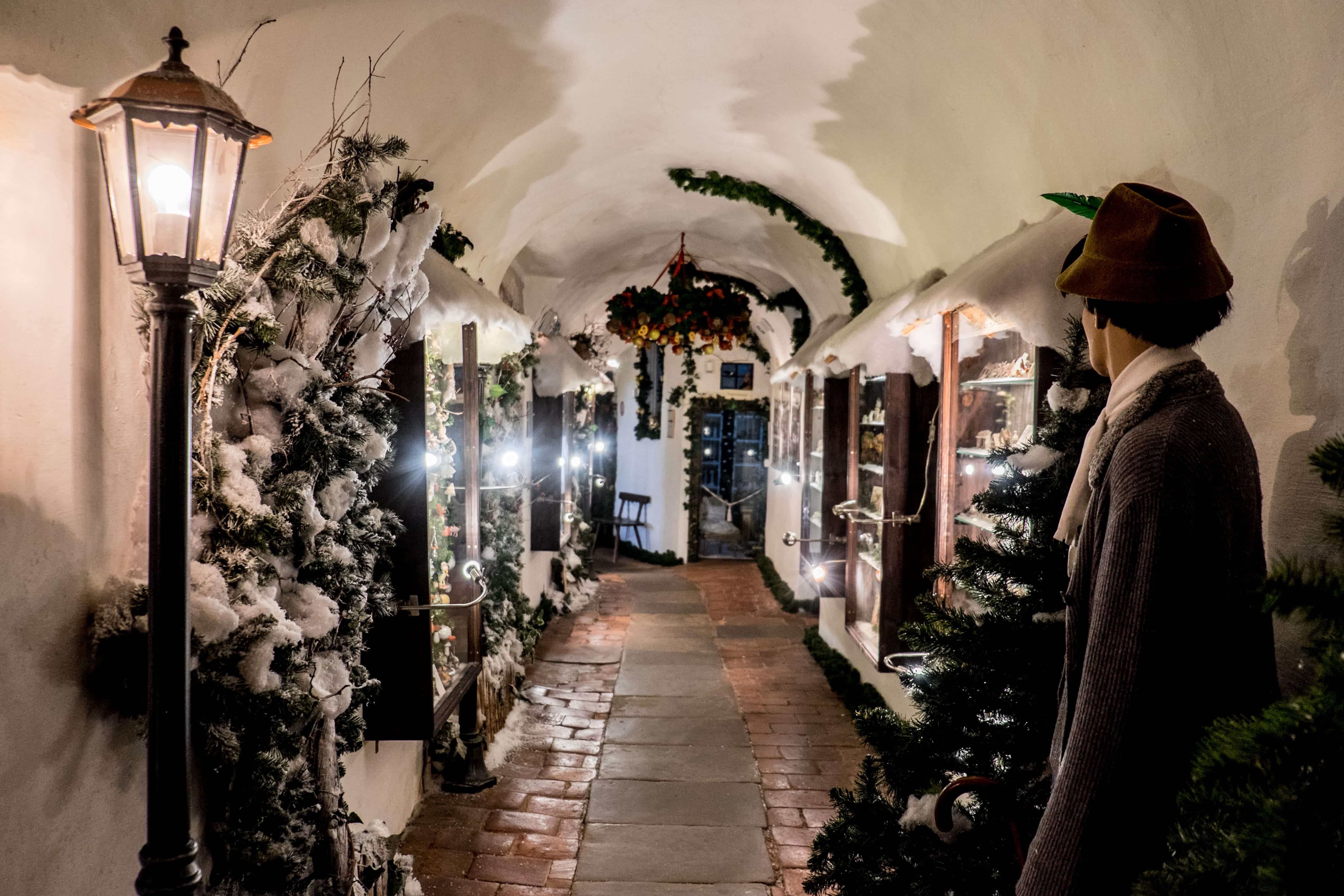
Inside Steyr’s famed Christmas Museum.
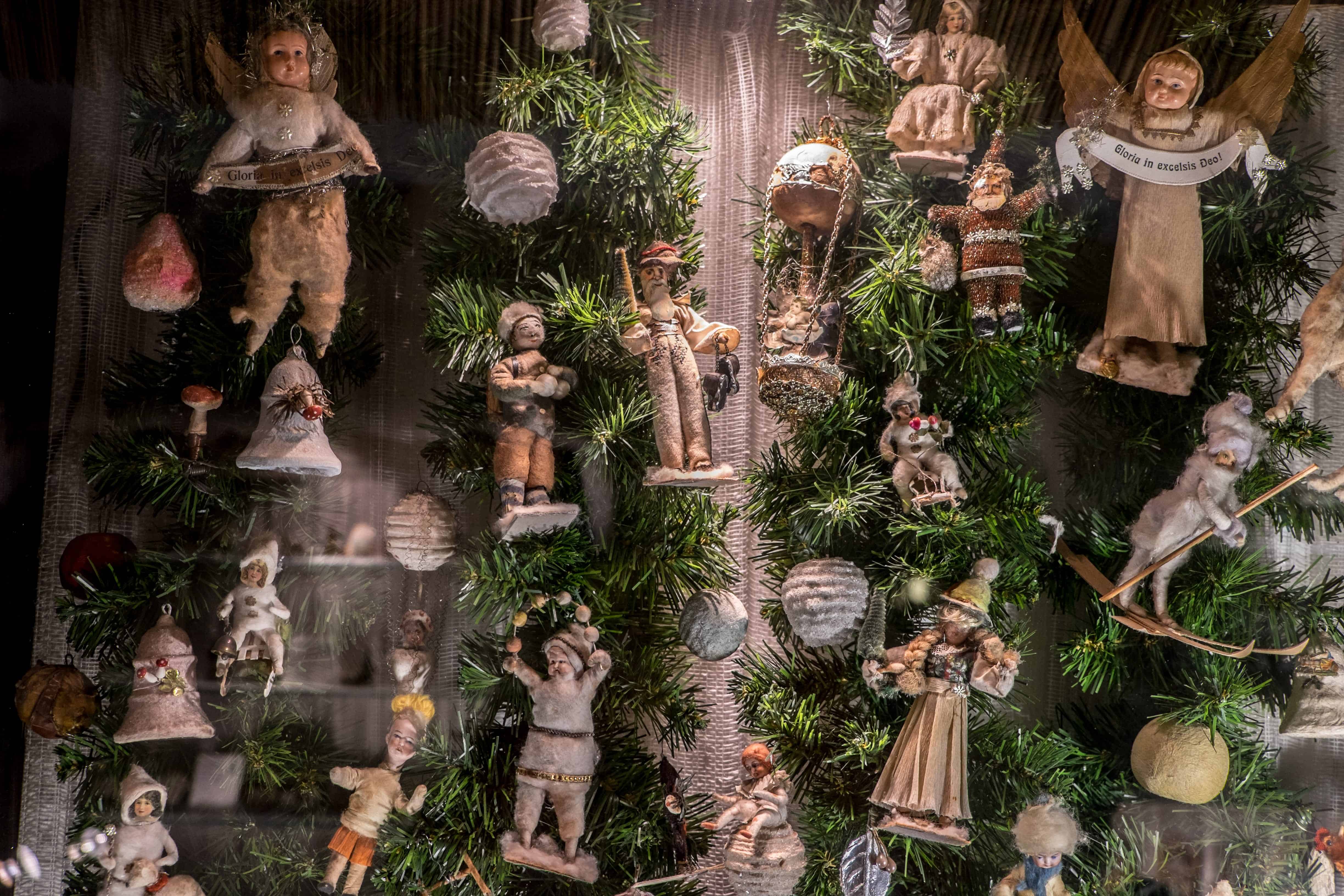
Some of 14,000 antique Christmas decorations in the Steyr Christmas Museum.
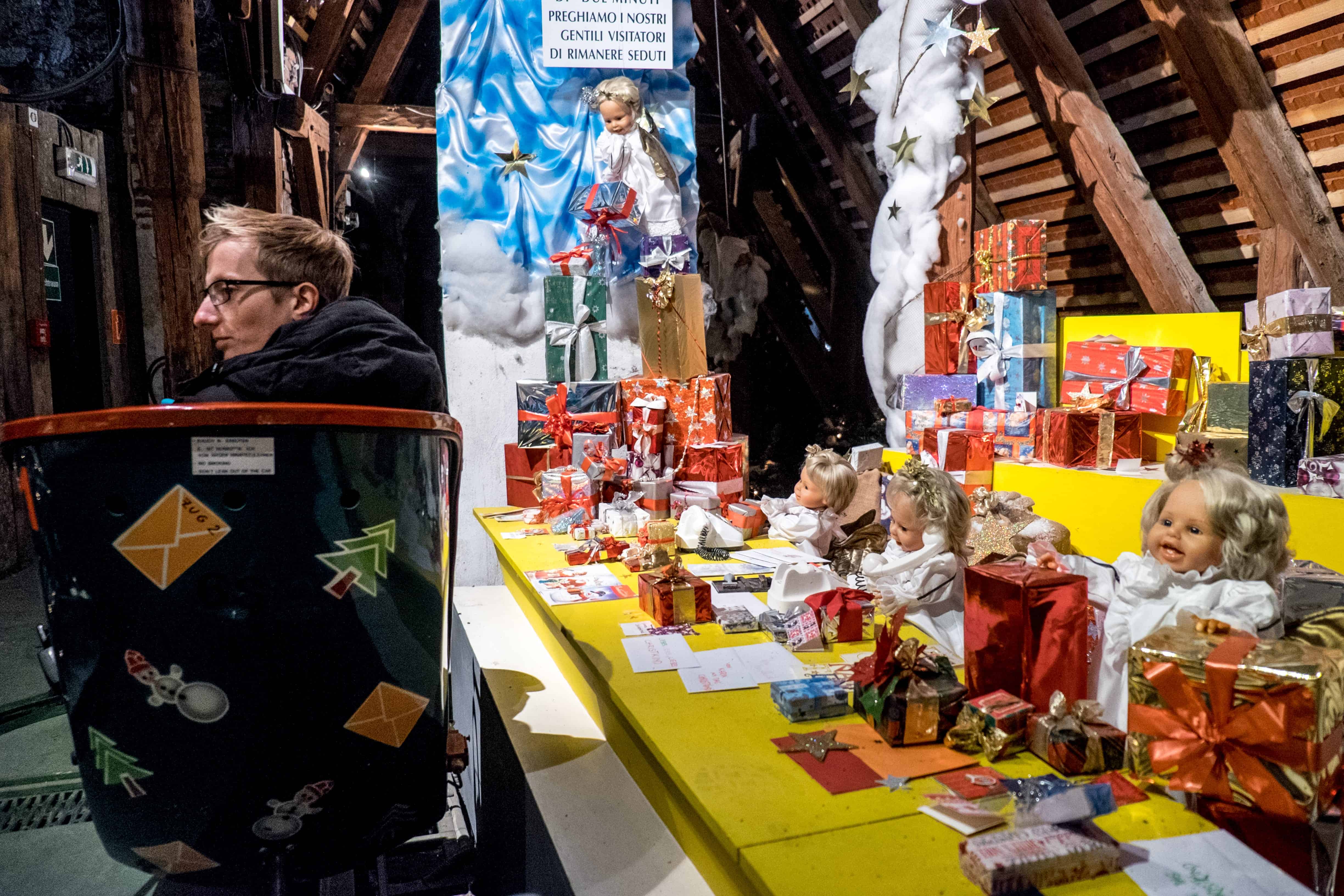
Advent in Austria should include a ride on the Steyr Christmas Museum Train.
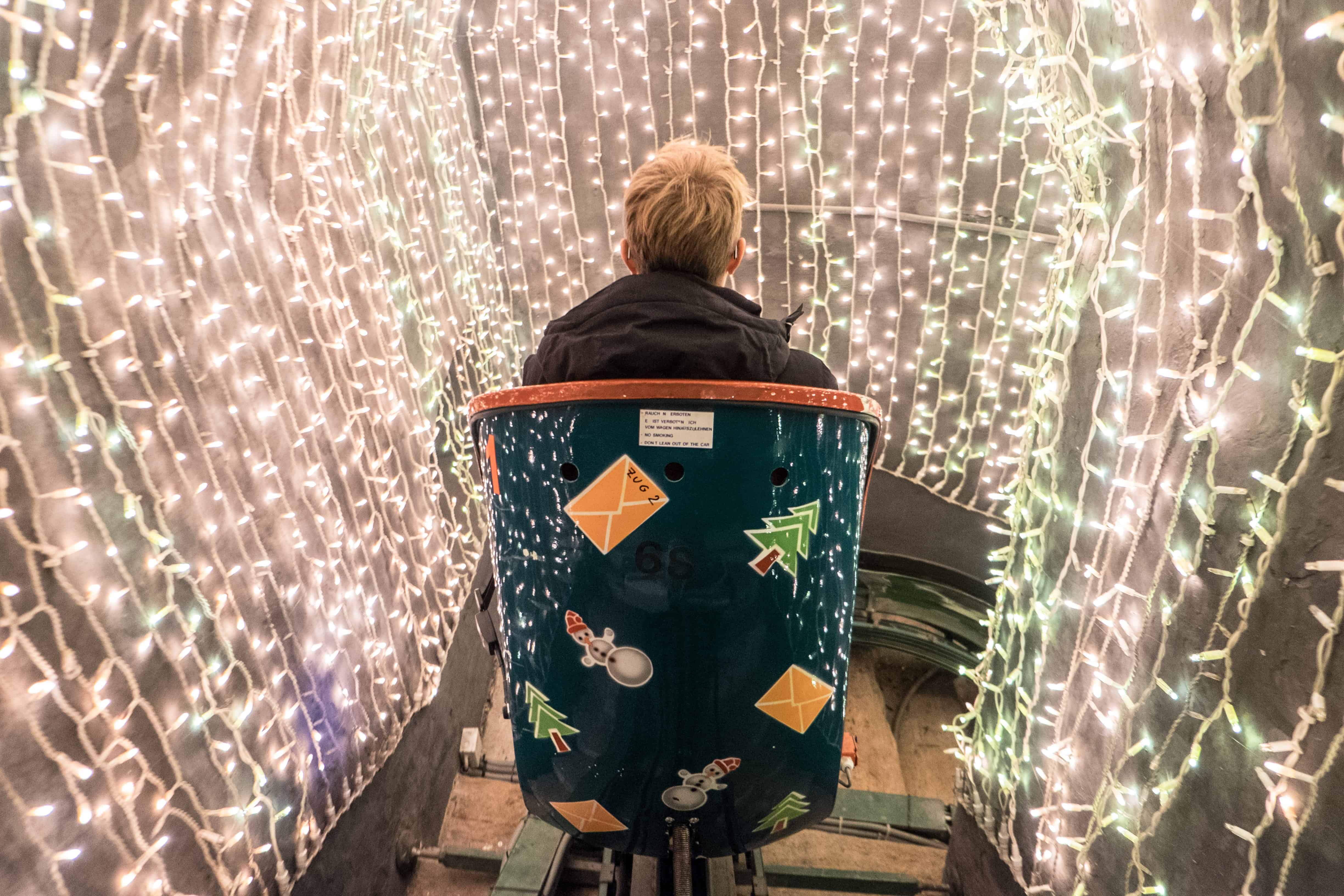
The Christmas train rolls down between the floors of the Christmas Museum.
Christkindl Town
You can hire dedicated guides to take you to the region’s highlights and give you a potted history of their hometown, so I continued with Wolfgang to the tiny town of Christkindl.
It’s so compact that you can see everything in less than half a day, but for those looking to indulge in the trail of advent with more time, you can go on the marked Christkindl Pilgrimage Trail and hike to the neighbouring towns of Christkindl or Garsten from Steyr.
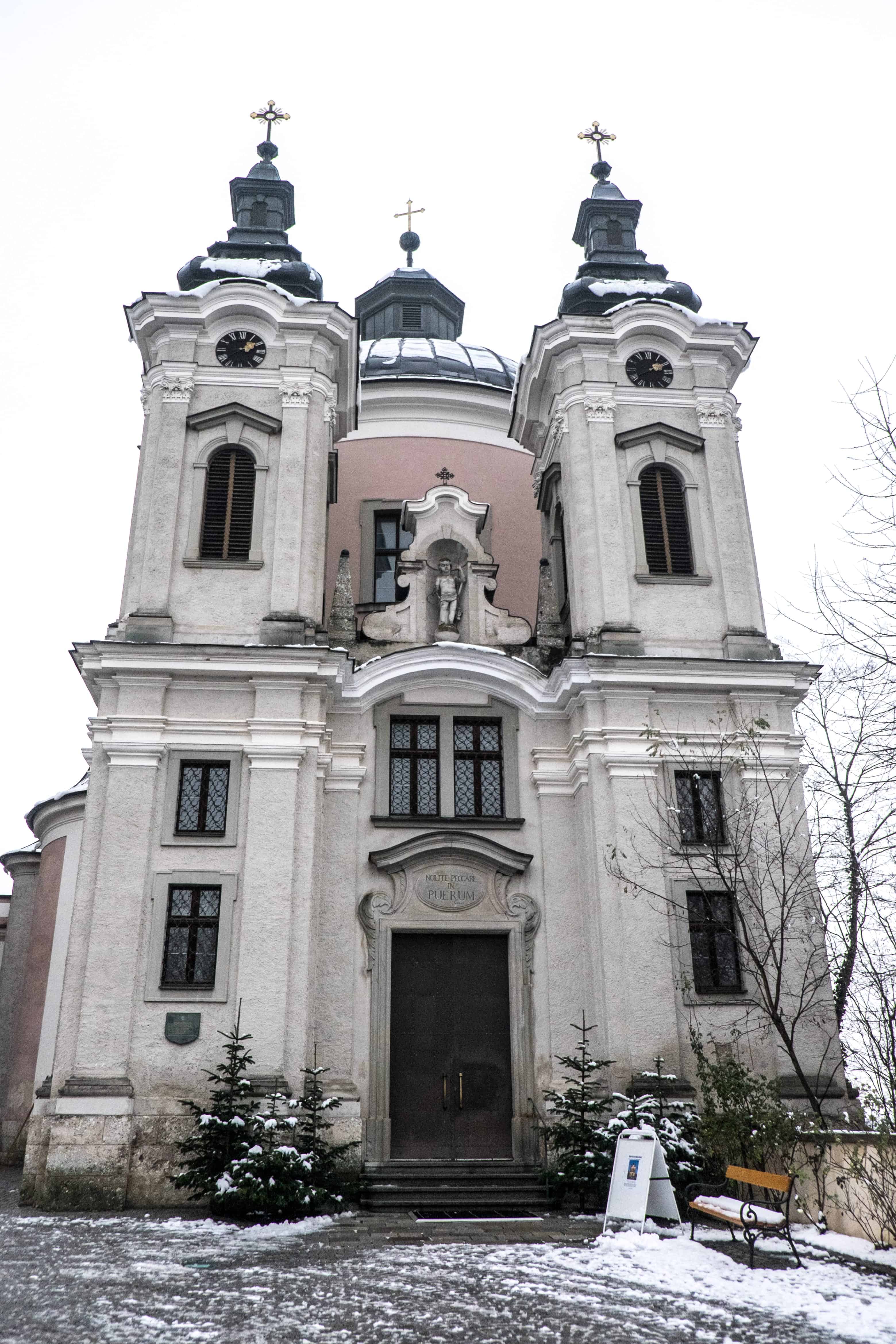
The famous Christkindl Pilgrimage Church in the town of Christkindl, Steyr.
Highlights in Christkindl include a chance to look around the pilgrimage church of Christkindl – which gives the town its fame – where people flock to see the shrine where a healing miracle once occurred at a tree. A tiny wax baby Jesus marks it, and the shrine still has part of the original tree in its structure.
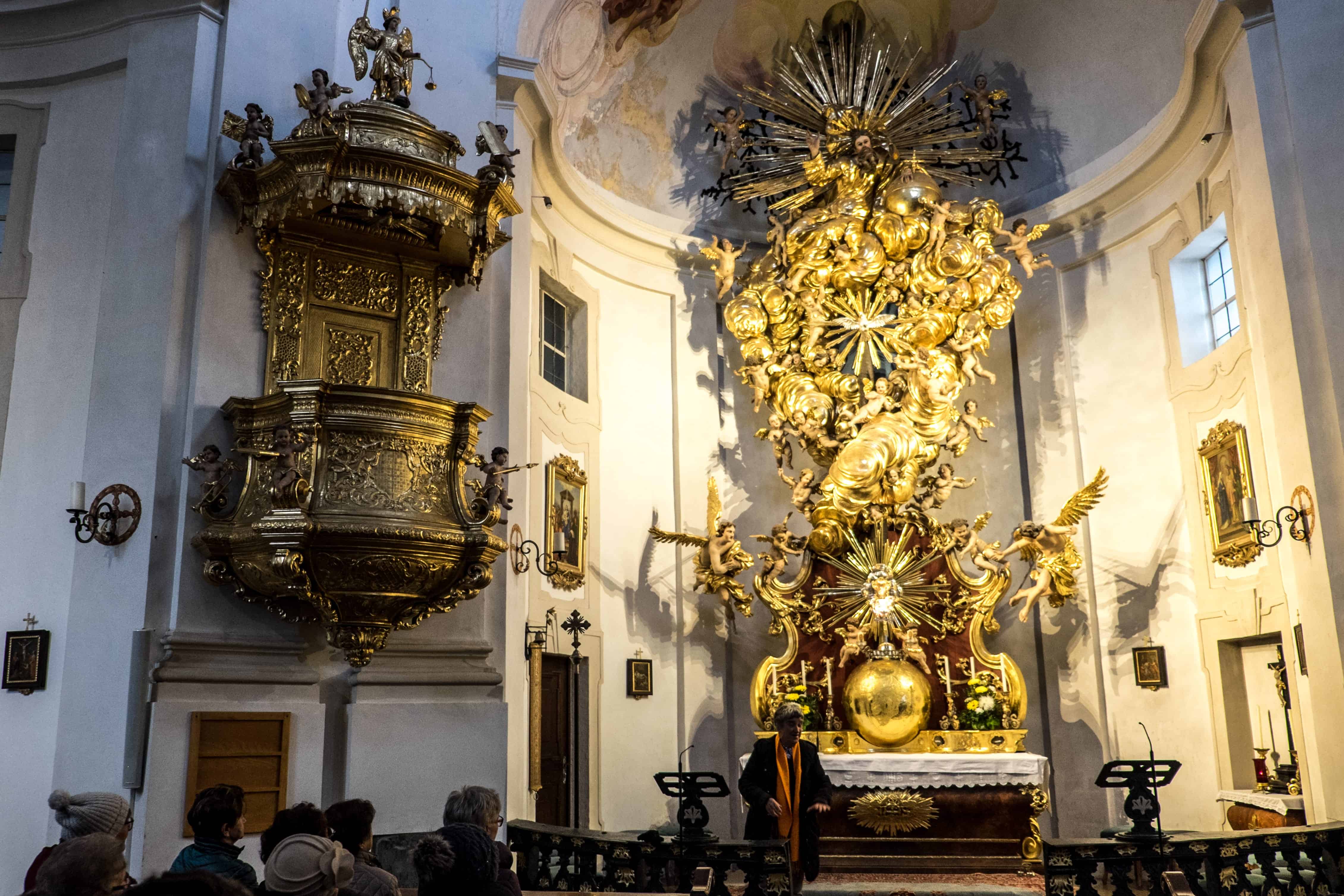
See the wax Jesus at the Christkindl Church Shrine.

A closer look at the Wax Jesus Shrine in Christkindl.
In the neighbouring hotel, you’ll find the famous Christkindl Post Office where visitors will send over 2 million letters at advent. Choose themed postcards and envelopes, finish with a special Silent Night stamp and continue a tradition that started in the 1950s.
Austrians also adore their Christmas Cribs and most families have one in their home during advent, with Christkindl being the place to see the very best. The Christkindl region is known for its collection of mechanical nativity scenes and puppets and delicately carved wooden cribs. You can learn more about the history of this tradition at the local museum and see various working musical cribs in action.
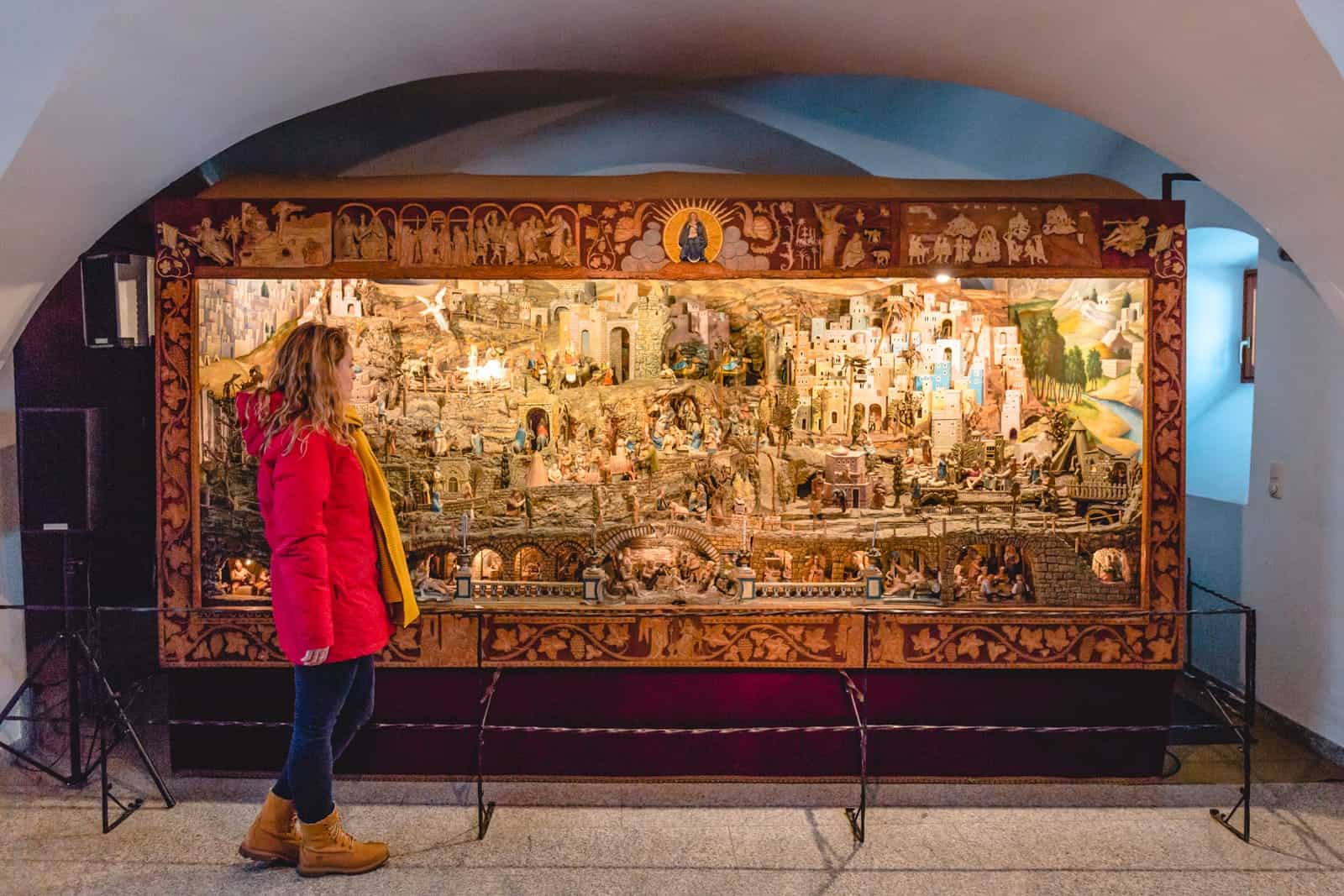
Christkindl Mechanical Crib – a must-see on an Austrian advent-themed trip.
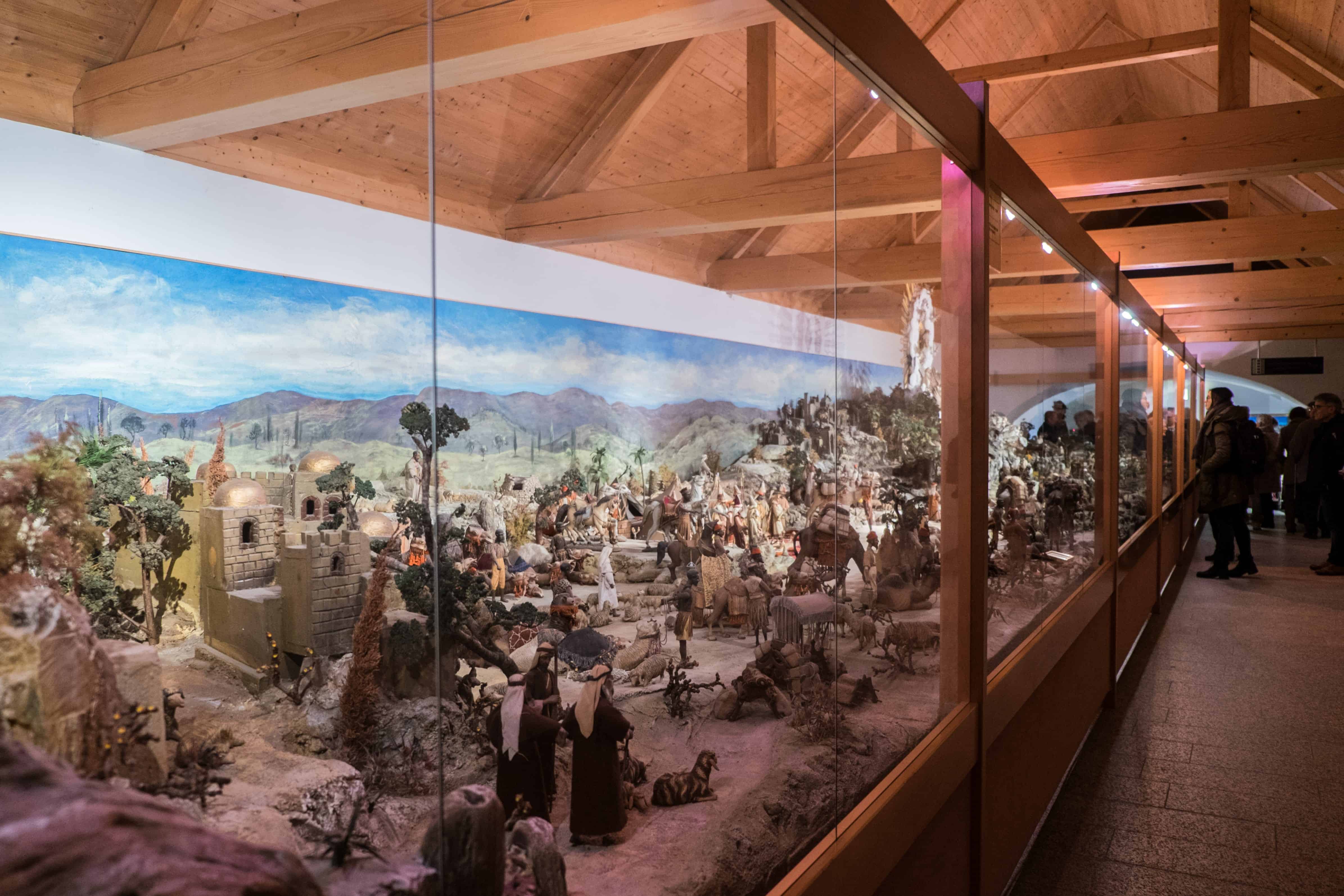
A giant Christmas Crib display in Steyr.
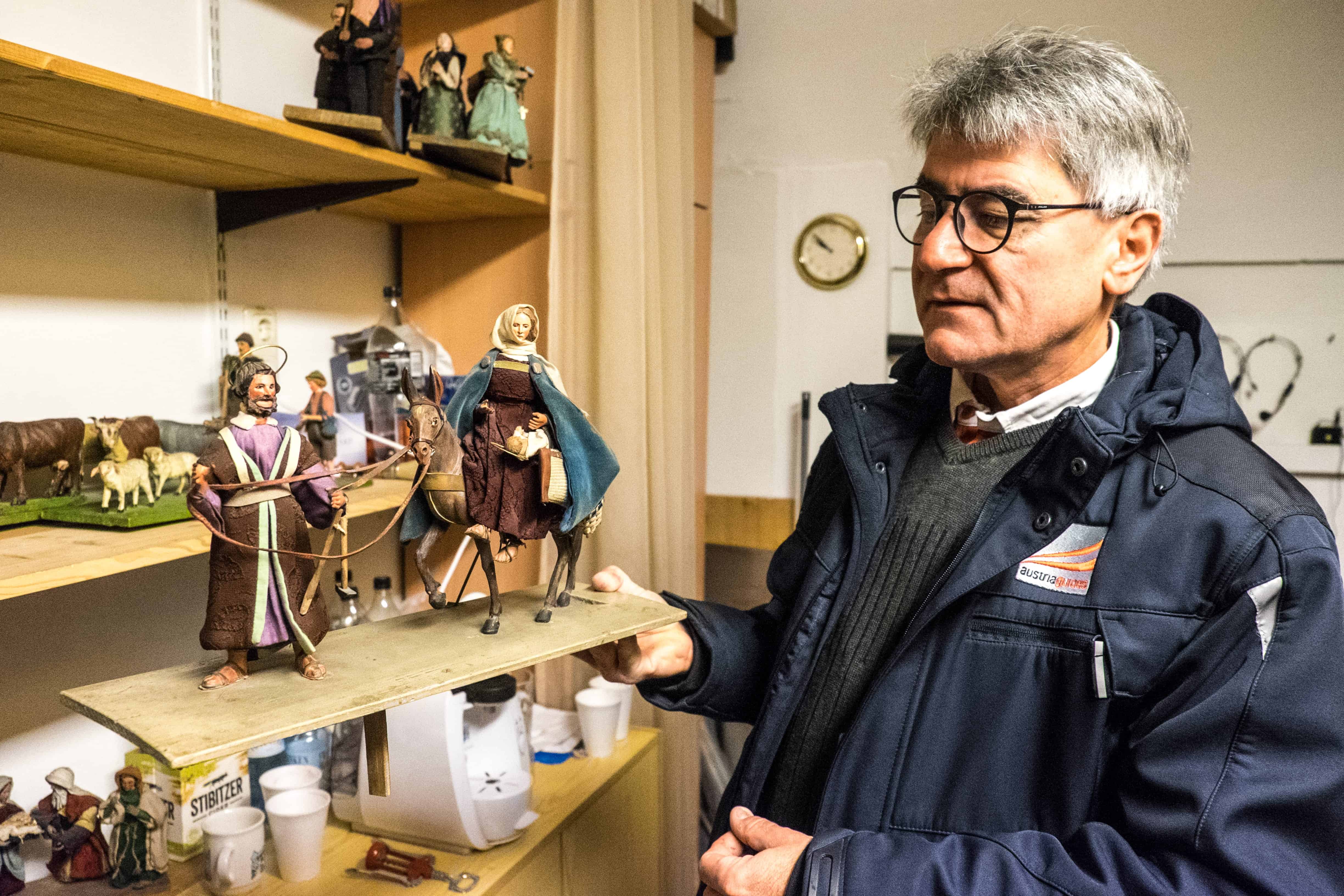
A closer look at the delicately carved Christmas Crib figurines.
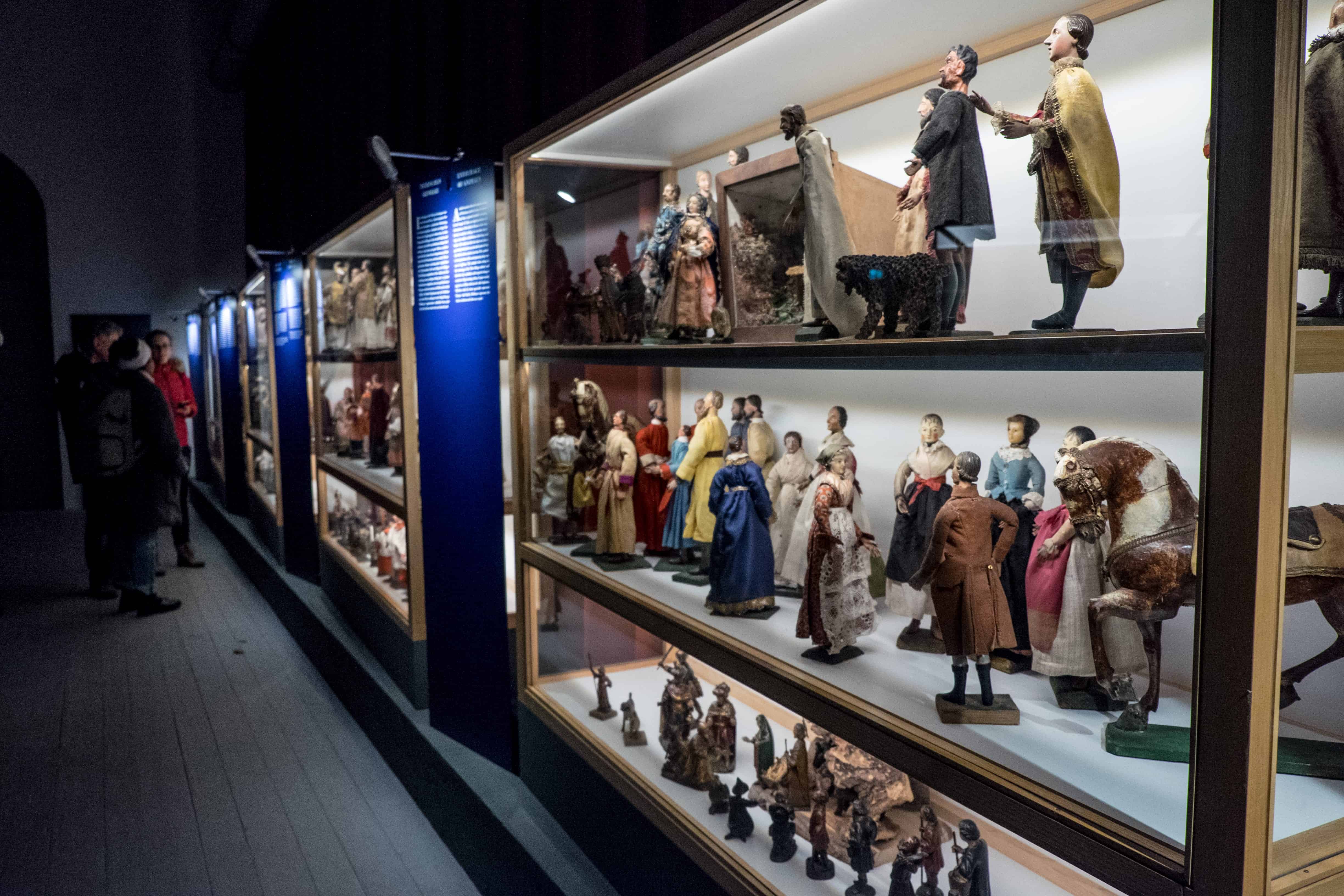
Exhibits at eh Crib Musuem in Steyr, Austria.
While here, don’t miss your chance to experience another Austrian advent tradition – to meet the Christkind. The Christkind (Christ Child) is the traditional gift bearer on Christmas Eve, and you can often meet the ‘real-life’ one at a Christmas market.
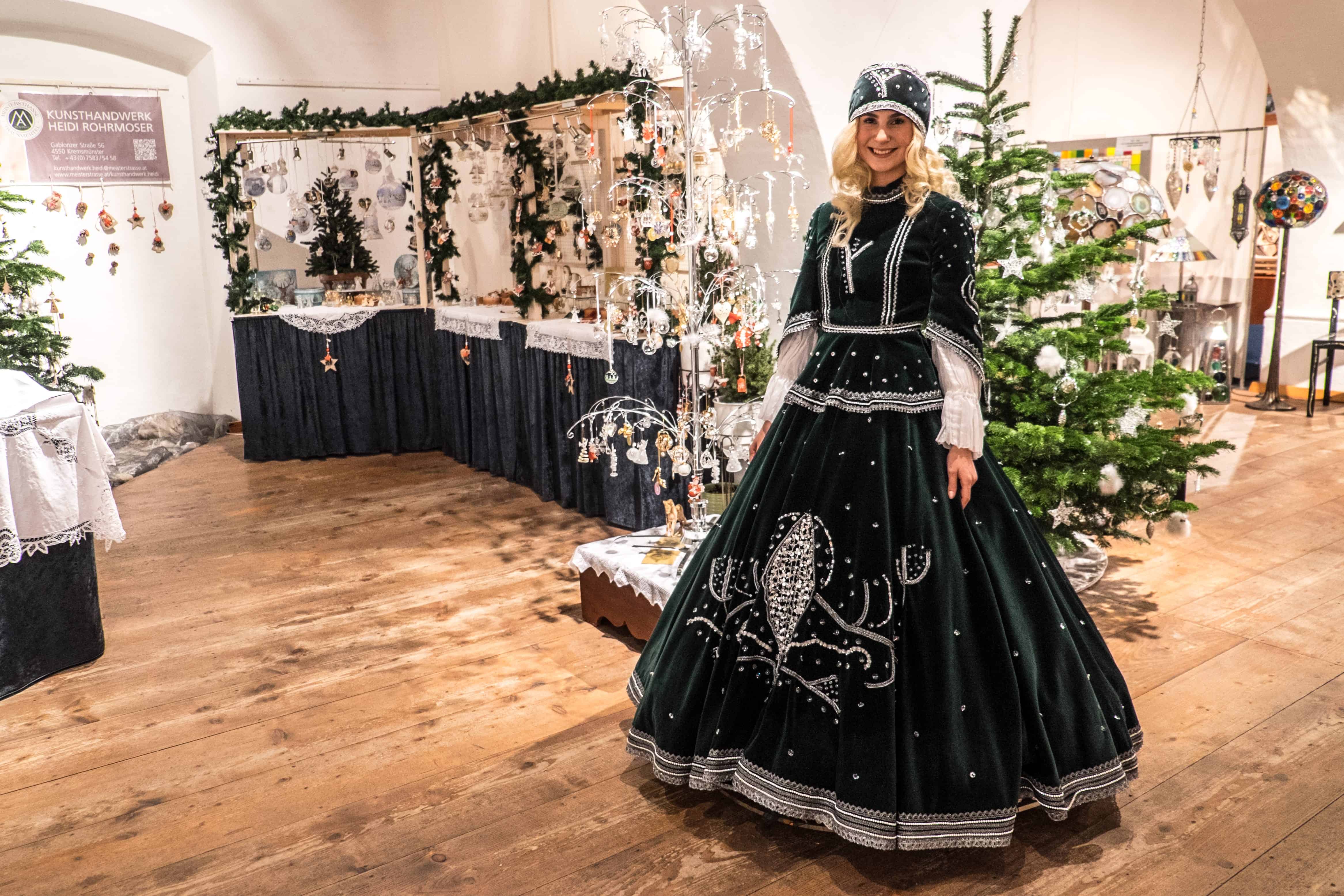
Meeting the Christkindl in Steyr.
Town of Ried im Innkreis
Ried is connected to Silent Night because the town’s Museum Innviertler Volkskundehaus houses the original crib in the Silent Night Chapel in Obernsdorf, SalzburgerLand, when the song was very first performed.
It is on display as part of the Christmas exhibition, finding its way to Ried after the Nativity scene was given away, stored and later sold following the demolition of the St. Nikola Church.

The Silent Night Chapel Crib in the Museum Innviertler Volkskundehaus in Ried, Austria.
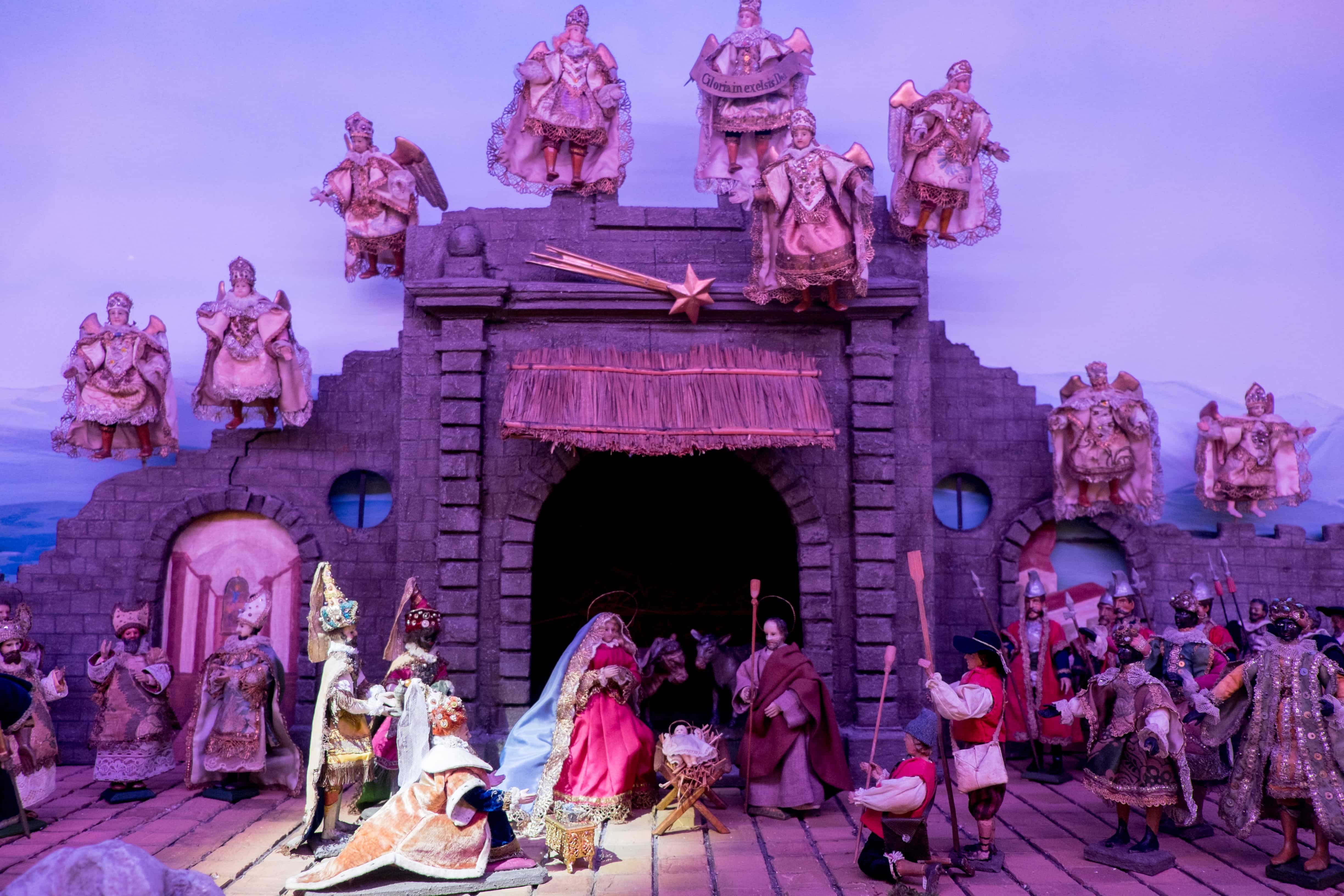
Part of the Silent Night Chapel Crib in the Museum Innviertler Volkskundehaus in Ried.
As a preserved part of the song’s heritage, the newly renovated crib takes up the length of the room with interactive light and a sound display system so you can learn more about how it was built and what each part represents, from the three wise men to a later-added typical wedding scene.
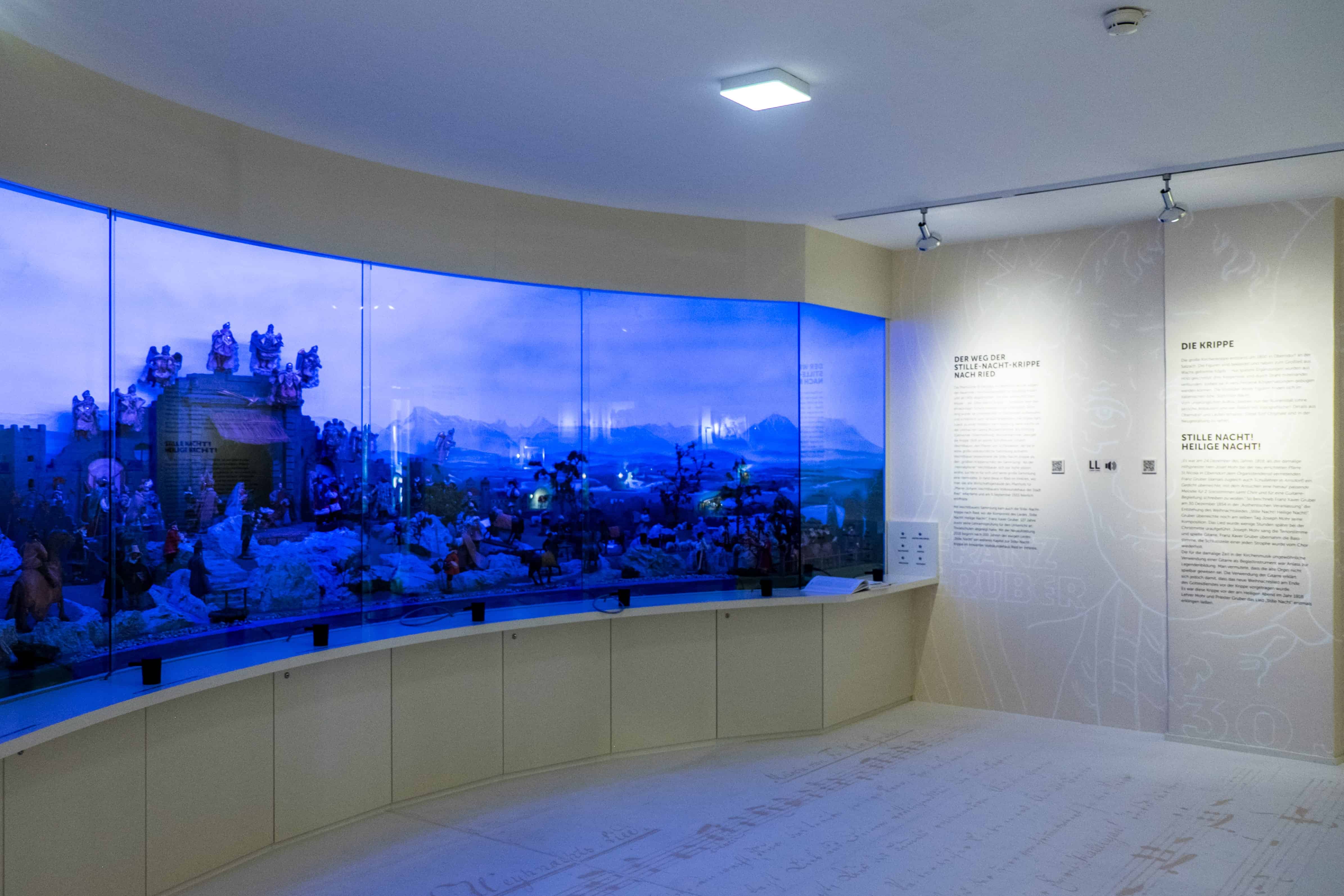
Silent Night Chapel Crib exhibit that fills the entire room.
Ried town also has a treasure hunt style of Crib window displays, marked by the Silent Night logo. The Silent Night Crib Walk comprises 30 nativity scenes in shop windows and public spaces in the centre of Ried im Innkreis.
The Krippenweg starts in Rainerstraße, passing through the squares and pretty streets of the city centre, and eventually ends at the original Silent Night Crib in the museum at Kirchenplatz.
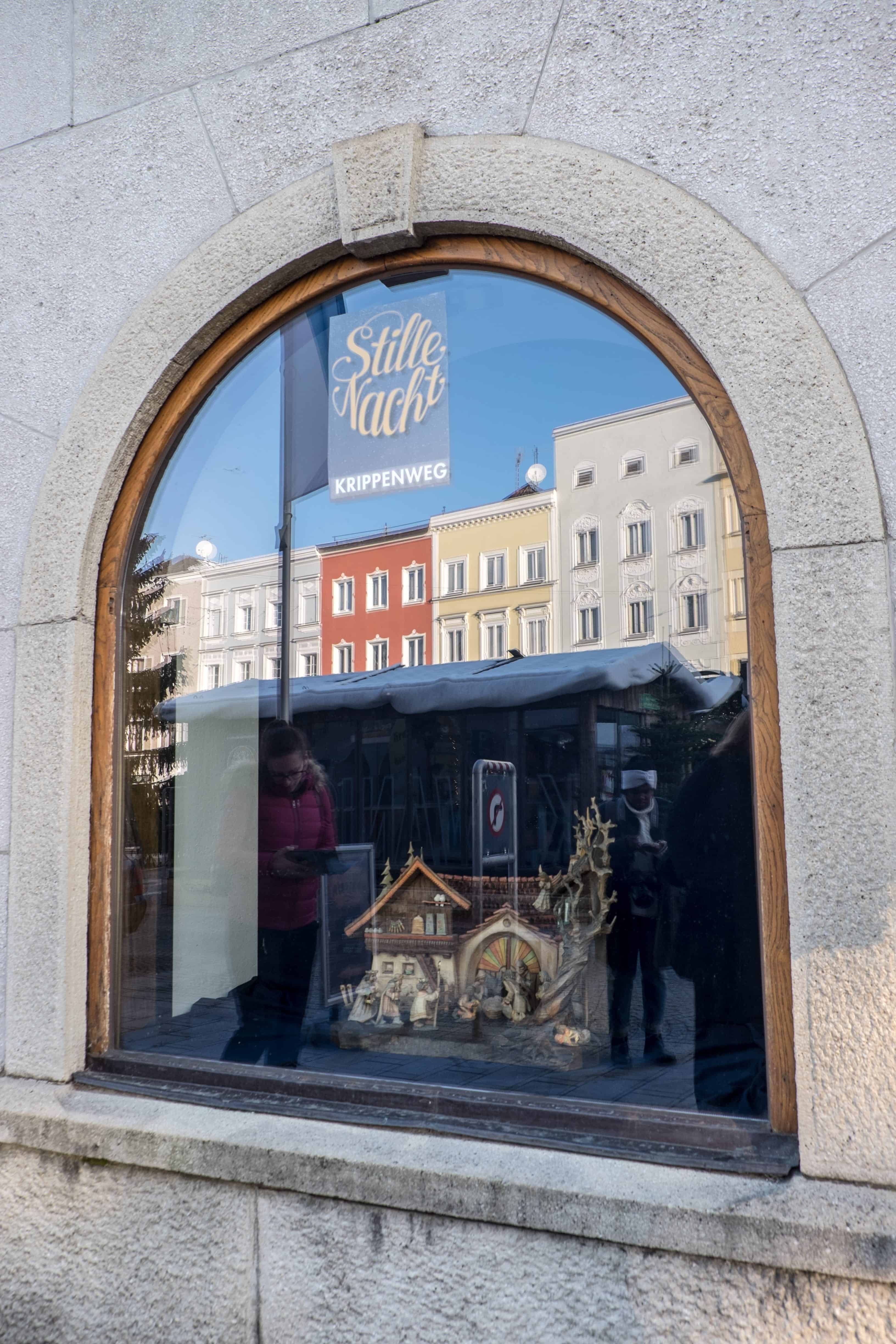
One of the Silent Night Crib Walk window displays in Ried, Austria.
Hochburg-Ach
In nearby Hochburg-Ach, visitors on the Silent Night trail can visit the birth house of Silent Night composer Franz Xaver Gruber.
This is not the original house but built as a replica using the materials of a house that stood right next to it. The creaking wood adds to the timeless feels as you wander around a small exhibition of Gruber’s life, including his original organ.
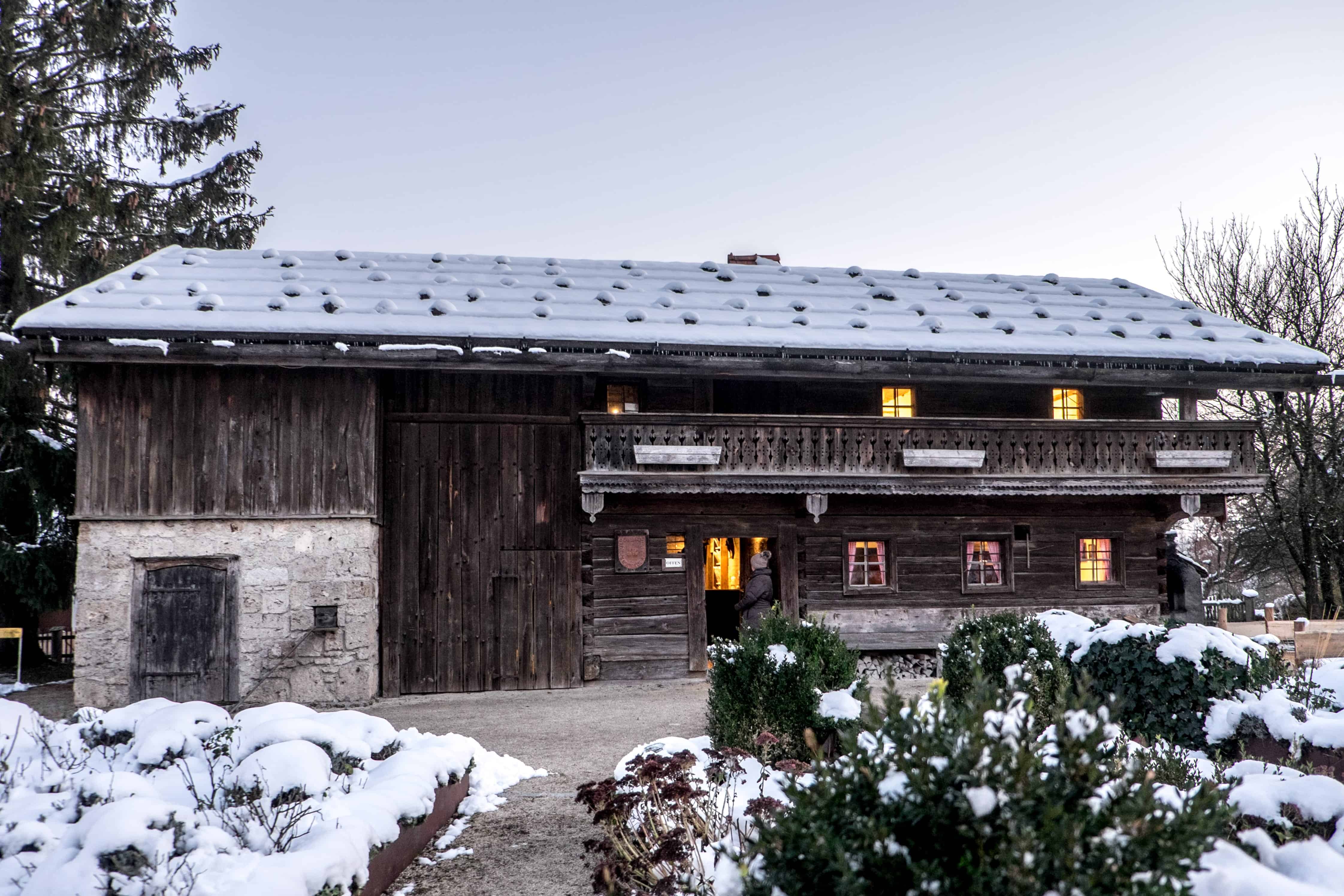
Visit the birth house of Silent Night composer Franz Xaver Gruber in Hochburg-Ach.
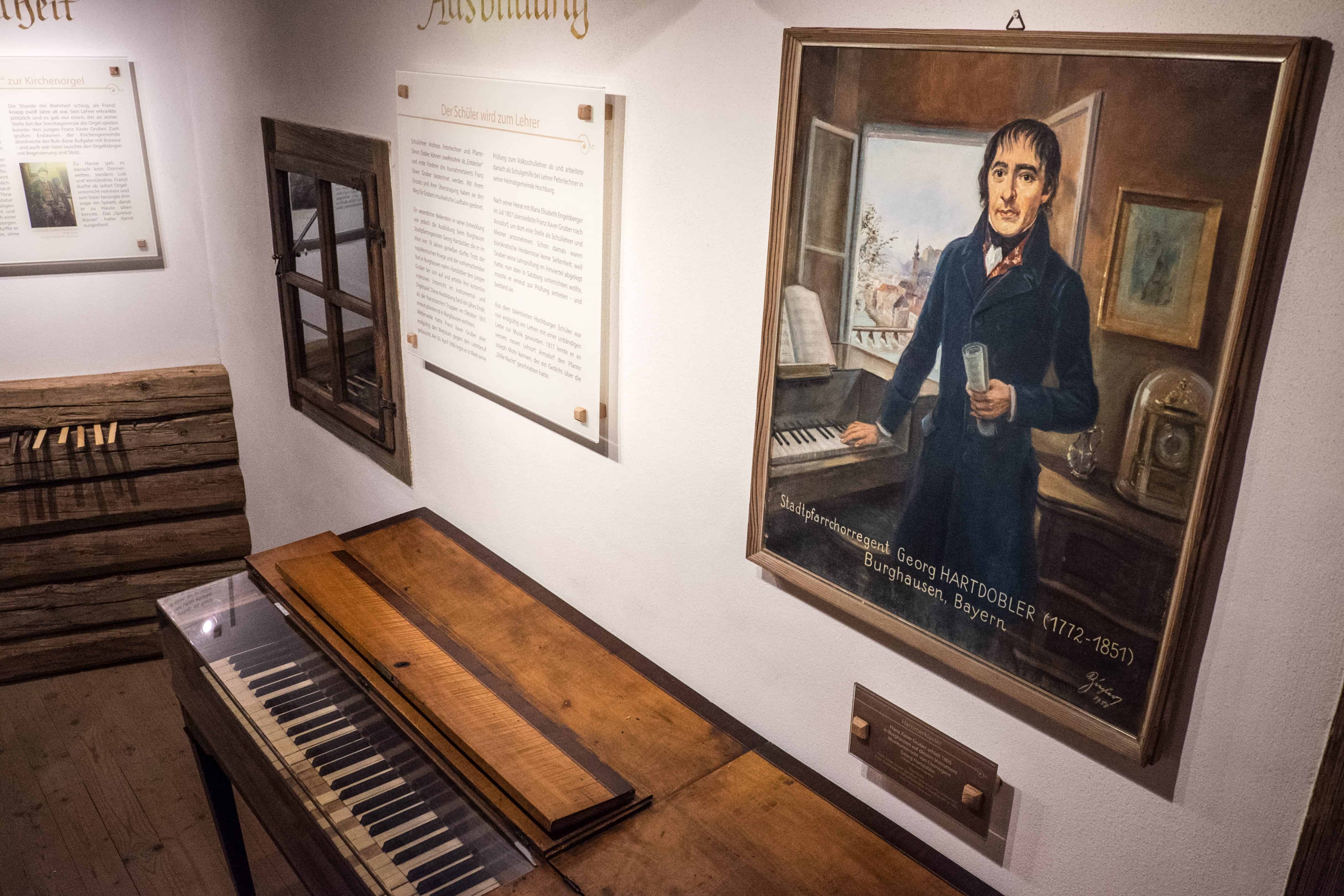
Franz Xaver Gruber’s organ on display in his Birth House in Austria.

Exhibits inside Silent Night Composer, Franz Xaver Gruber’s House.
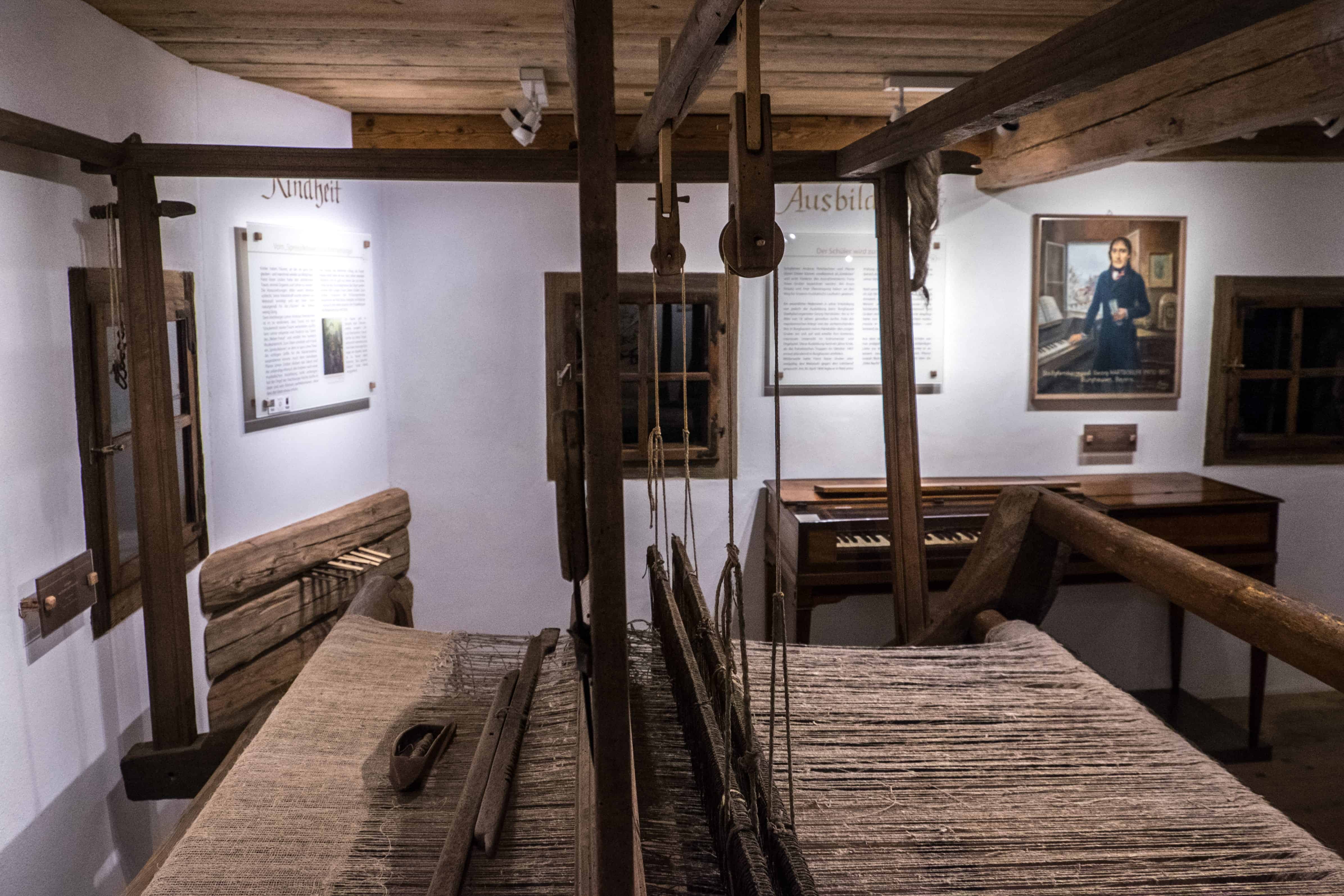
Franz Xaver Gruber Birth House Museum.
Here, I got to taste the special Silent night beer – a light and tasty stout available in stores on-site at the many Silent Night Museums alongside other memorabilia.
Also in Hochburg-Ach, you can walk the Franz Xaver Gruber Peace Trail in the village marked by sculptures representing every continent. This was constructed not only to connect the village on a walking trail but also to promote a sense of unity and to discover the peaceful meaning of the song.
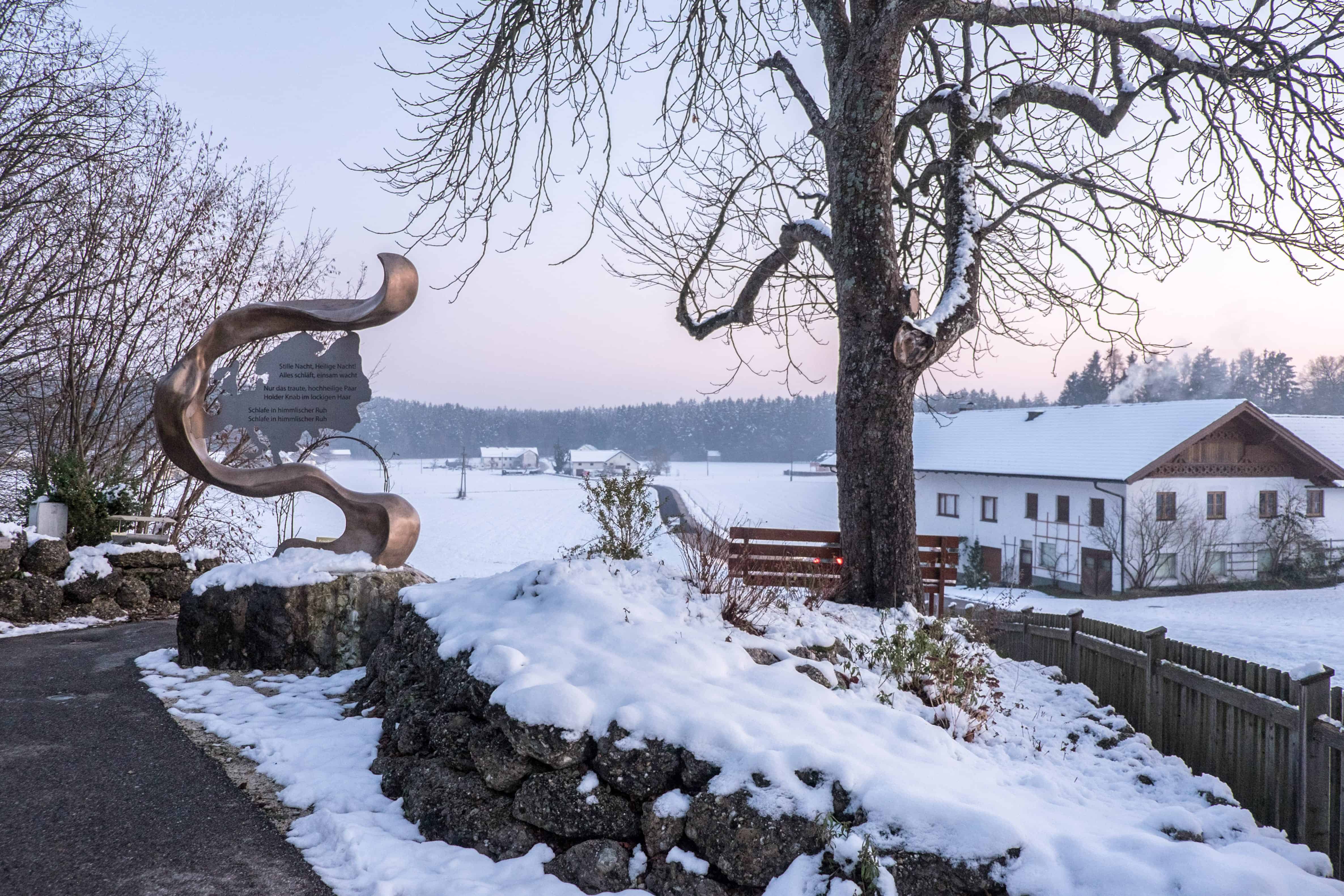
A Silent Night sculpture on the Franz Xaver Gruber Peace Trail inHochburg-Ach.
The Story of Silent Night in Tirol
Duration: 2 days
By the time you make it to Tirol (Tyrol), the Silent Night journey is all about the singing and how the song came to be taken from Austria and carried around Europe and beyond, including its long travel around North America.
Where to stay
Base yourself in Achensee and travel to the Zillertal Valley and Fügen on day trips. The traditional Tyrolean style Appartementhaus Sunshine is a budget offering in Achenkirch – a 10-minute walk from the north shores of the lake. The Traumhafter Seeblick: Ferienwohnung “Am Atoll” on the southern shores in Maurach is one of the top-rated guesthouses in the area.
Zillertal Valley
Laimach, in the Zillertal Valley, is where you’ll find the Strasser-Häusl. You can take a short walk here from below the church in Hippach on a short connecting path that runs past a barn to the Ziller and follows the river on the left for 1.5 km before a marked path branches off to a small church and then brings you to the romantic Strasser-Häusl on the left. Alternatively, the valley makes for a scenic drive.
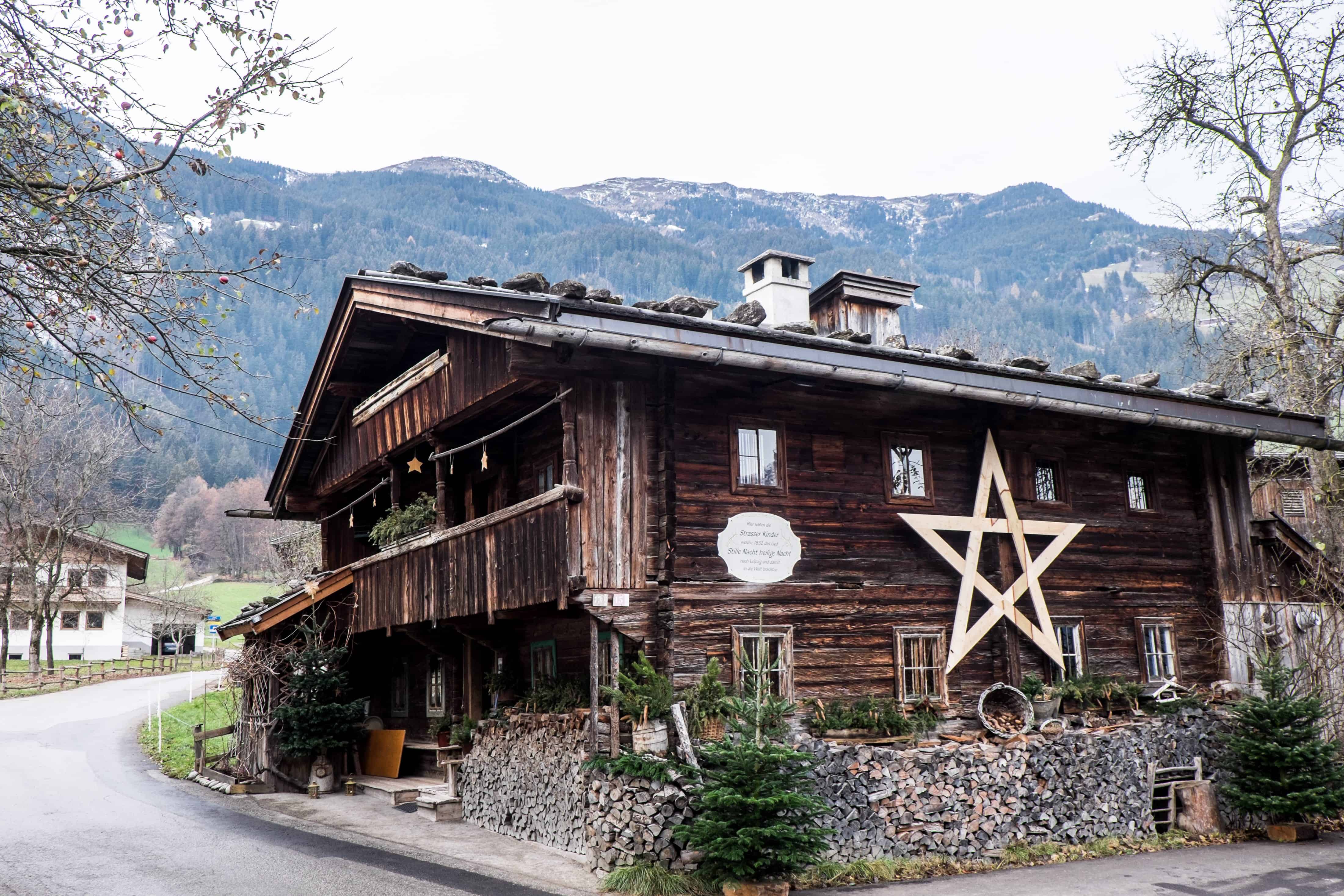
The Silent Night Strasser Family Singers’ House in Tirol, Austria.
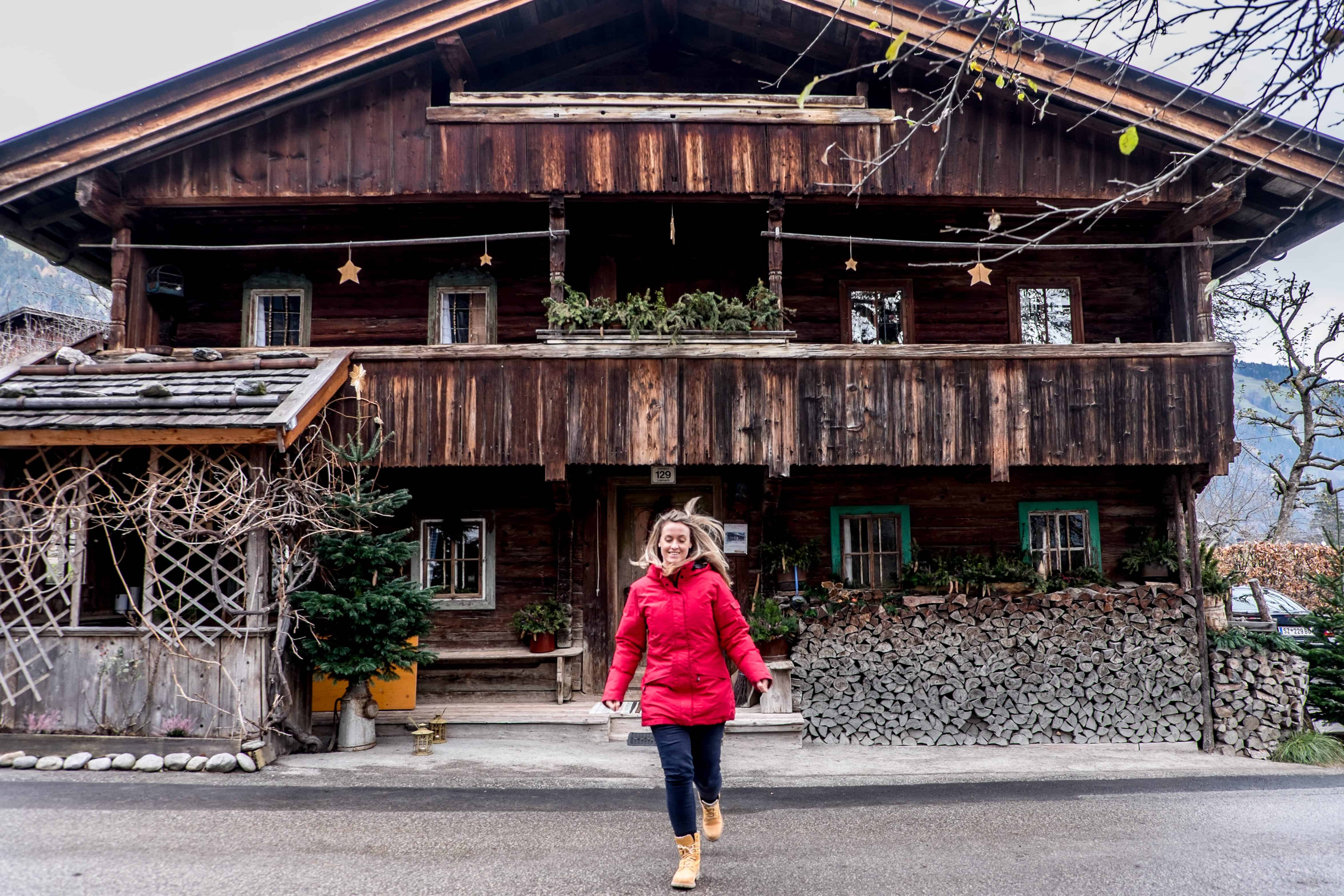
Outside the Strasser Family in the Zillertal Valley, Tirol.
This heritage-listed, beautiful, wooden Zillertal valley farmhouse stands out from the rest, lovingly restored by Mrs Rosi Kraft in 2000 and turned into a public museum.
The birthplace of the Strasser siblings dates from the 18th century and is filled with original fixtures, fittings and décor, as it would have been, including tiny details such as traditional windows, antique door fittings and typical kitchen and living space set-ups.
The museum contains original music sheets, pictures of the Strasser family and gloves from the time, as well as agricultural tools and other original exhibits.
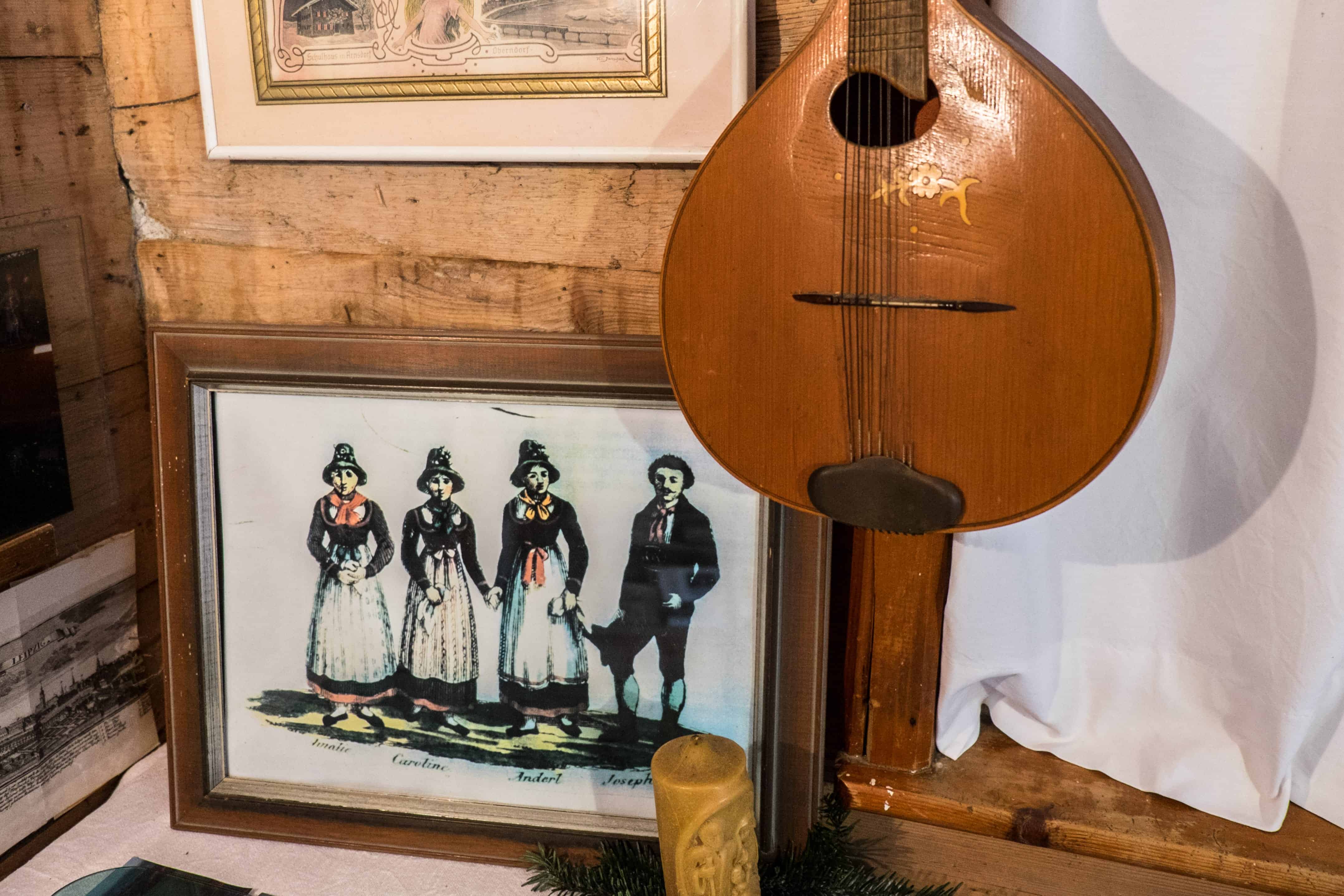
Exhibits from the Strasser Family Singers House.
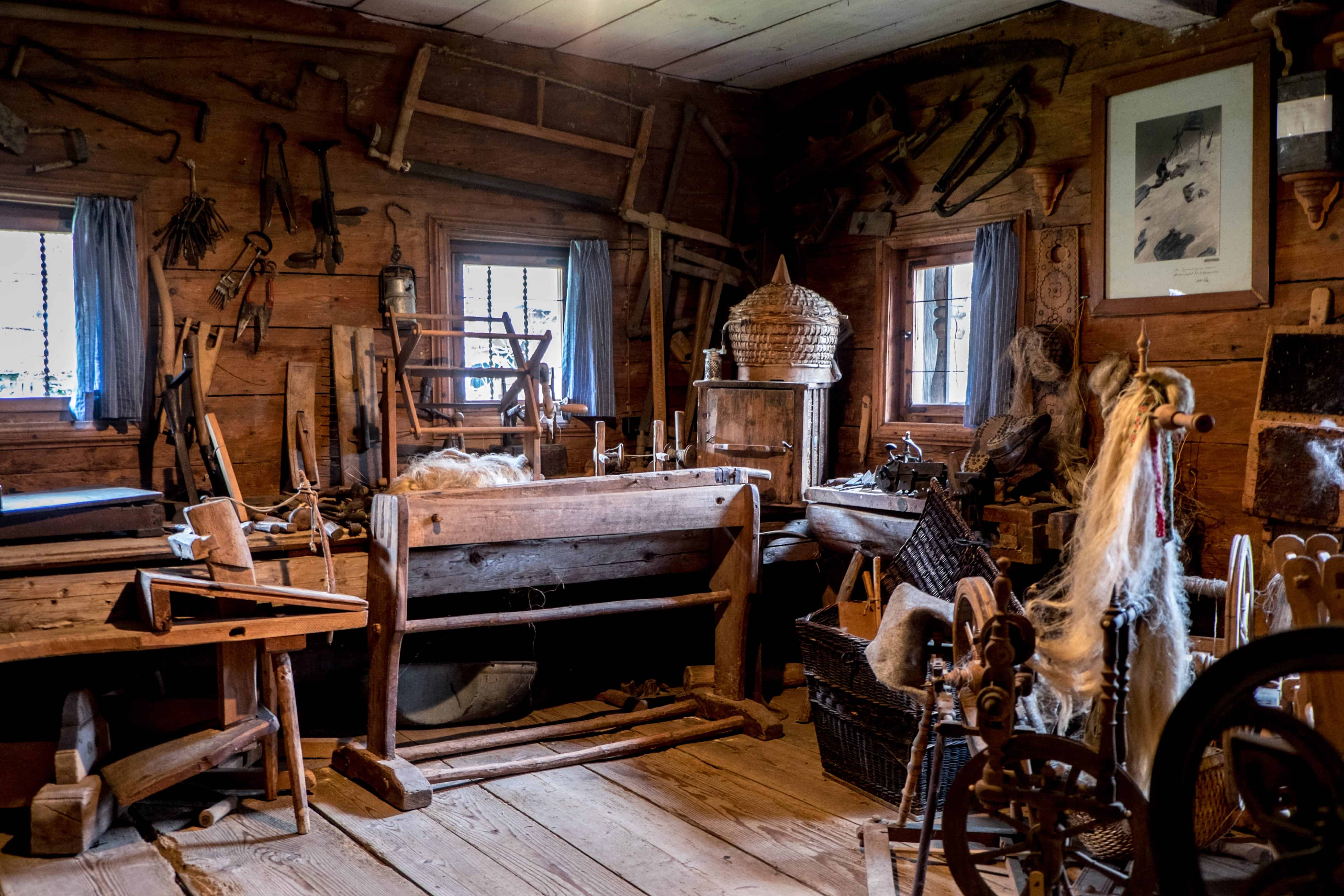
Inside the Silent Night singers, Strasser Family House Museum in Tirol.
It stands as a means of living history in testimony to the singing merchants from Zillertal, who realised that by singing, they attracted more customers at the market where they would sell local handicrafts, most notably the leather gloves. Silent Night was a part of their musical catalogue and from this means the song began to spread.
By 1831, the Strasser siblings sang Tyrolean songs in Leipzig to boost sales at their market stall, where Silent Night was first sung there at midnight mass I in the Pleisenburg Royal Saxon Court Chapel. A German publisher printed a book in 1833 in which this song was called “Folk song from Zillerthale” and so began the momentum of the song’s journey beyond the Tyrolean valleys.
Fügen
Fügen is the home to the second famous musical merchant group – the Rainer family singers. So how did Silent Night get from its performance in SalzburgerLand to the valleys of Tirol?
Carl Mauracher – the organ builder and repairer from Fügen brought the song from Oberndorf (where the Silent Night Chapel is based) to Tirol. The Rainer singers took the song with them on their journeys, are also from Fügen and created the Tyrolean national style of singing we know so well today.

Portrait of Silent Night organ builder Carl Mauracher at Fugen Castle Museum, Austria.
The first stop to learn about this timeline of history was Fügen Castle and the Museum at Widumspfiste for the “Klang der Alpen” exhibition, about the history of Tyrolean singers and the alpine music business.
A large section is dedicated to the story of the Rainer family, who carried the Silent Night song to North America and Russia, alongside dedications to other singing families such as Strasser and Hauser, who all started the journeys of concert tours.

Exhibits related to Tyrolean singers and the alpine music business.
From humorous four-line poems, sung by competing singers, and seen as the earliest collection of folk songs in Austria, to the traditional Tyrolean dance of the Tramplan, this interactive musical journey is where you can even practice Tyrolean dance moves and yodelling sounds.

Hauser Family poster at Fugen Castle Museum.

Singing family exhibits.

Strasser Family Singers poster.
Schloss Fügen also holds significance in the journey of Silent Night. In 1822, Count Dönhoff of Fügen asked the Rainer Siblings to sing at his residence (the castle) in front of the Kaiser of Austria and the Tsar of Russia.
From there the family got letters of recommendation and it opened the doors into other aristocratic circles and the chance for the song to spread wider. In 1827, the Rainer family travelled Hamburg to London and met with King George IV who had costumes tailored for them. It was here that Maria Strasser famously kissed the King causing quite the scandal of the time!
Achensee
In Achensee, you can continue on the trail of the Rainer singers and their relationship with the Silent Night song.
The main site is the local museum Sixenhof on the banks of Lake Achensee. Since November, a new exhibition has been set up dedicated to the famous international singer Ludwig Rainer (son of Maria from the first generation of Rainer Singers).
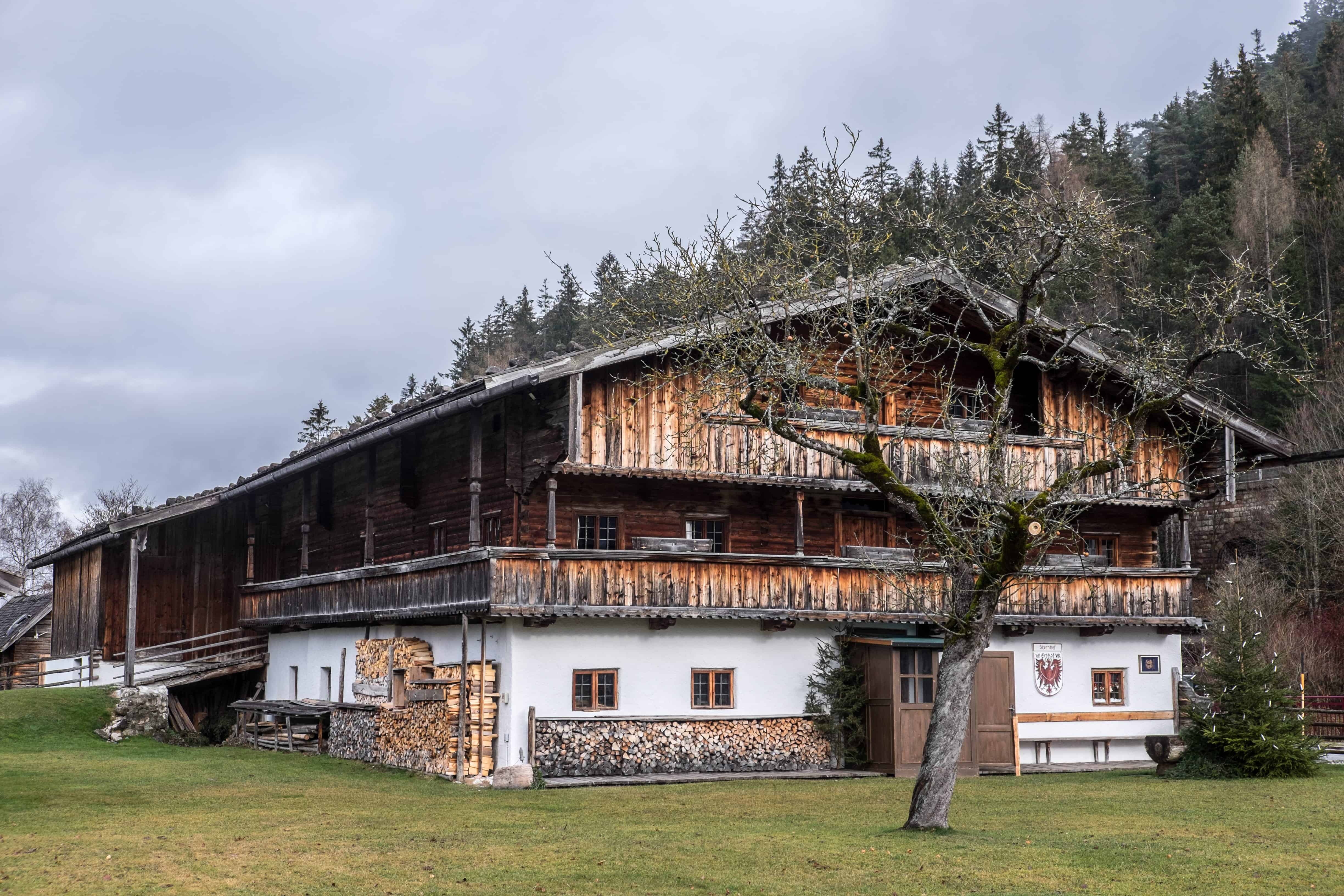
Alpine hut Sixenhof Museum in Achensee, Austria which houses a Silent Night exhibition.
The second generation of Rainer singers travelled America from 1839-1843 from Quebec down to New Orleans. Christmas Day 1839 is said to be where the song was first performed in New York at the Alexander Hamilton Memorial (in the Trinity Church cemetery, end of Wall Street). Ludwig Rainer performed with three friends, travelling and singing in a group known as The Rainer Family.
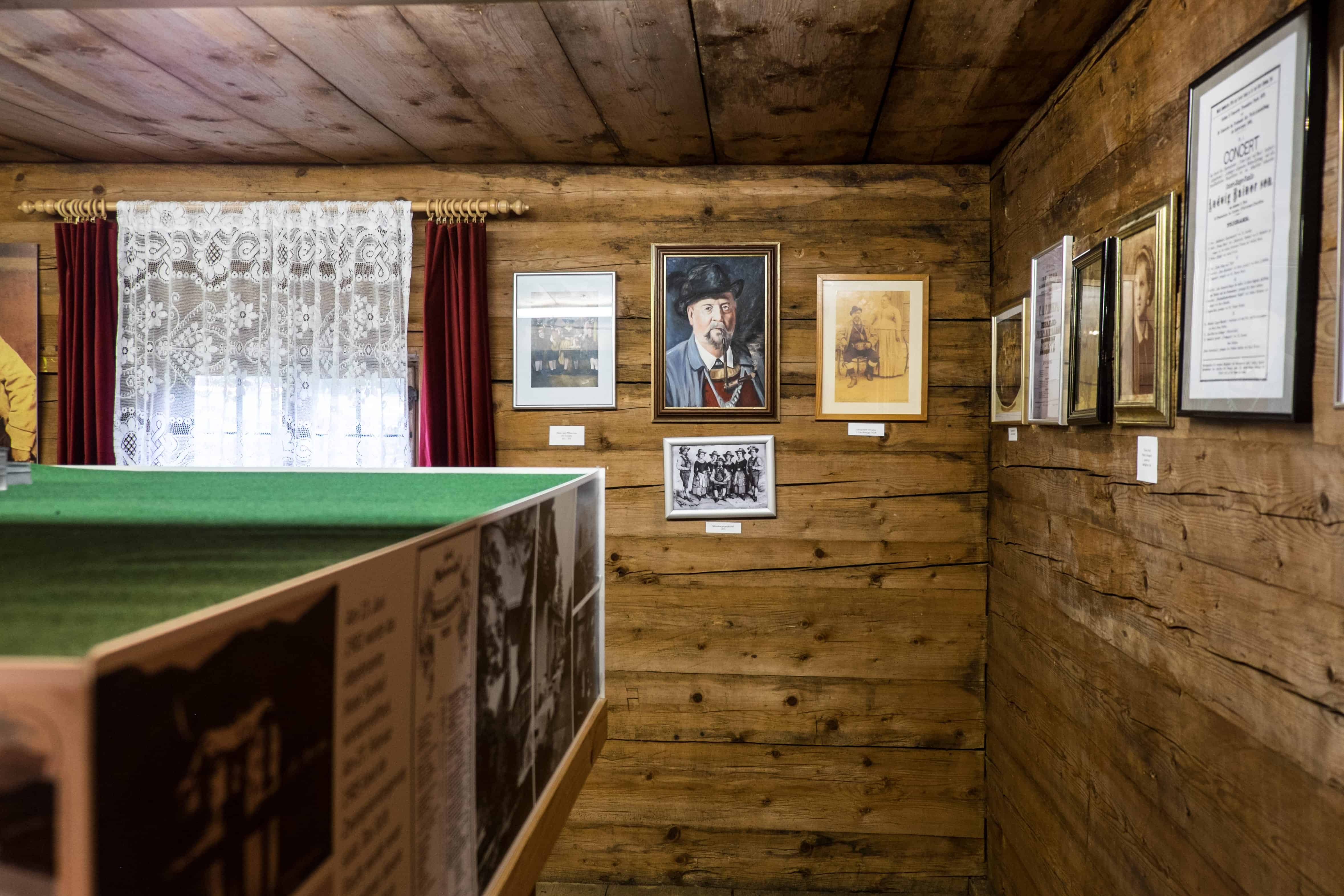
Rainer family singers exhibit at Sixenhof Museum, Achensee.
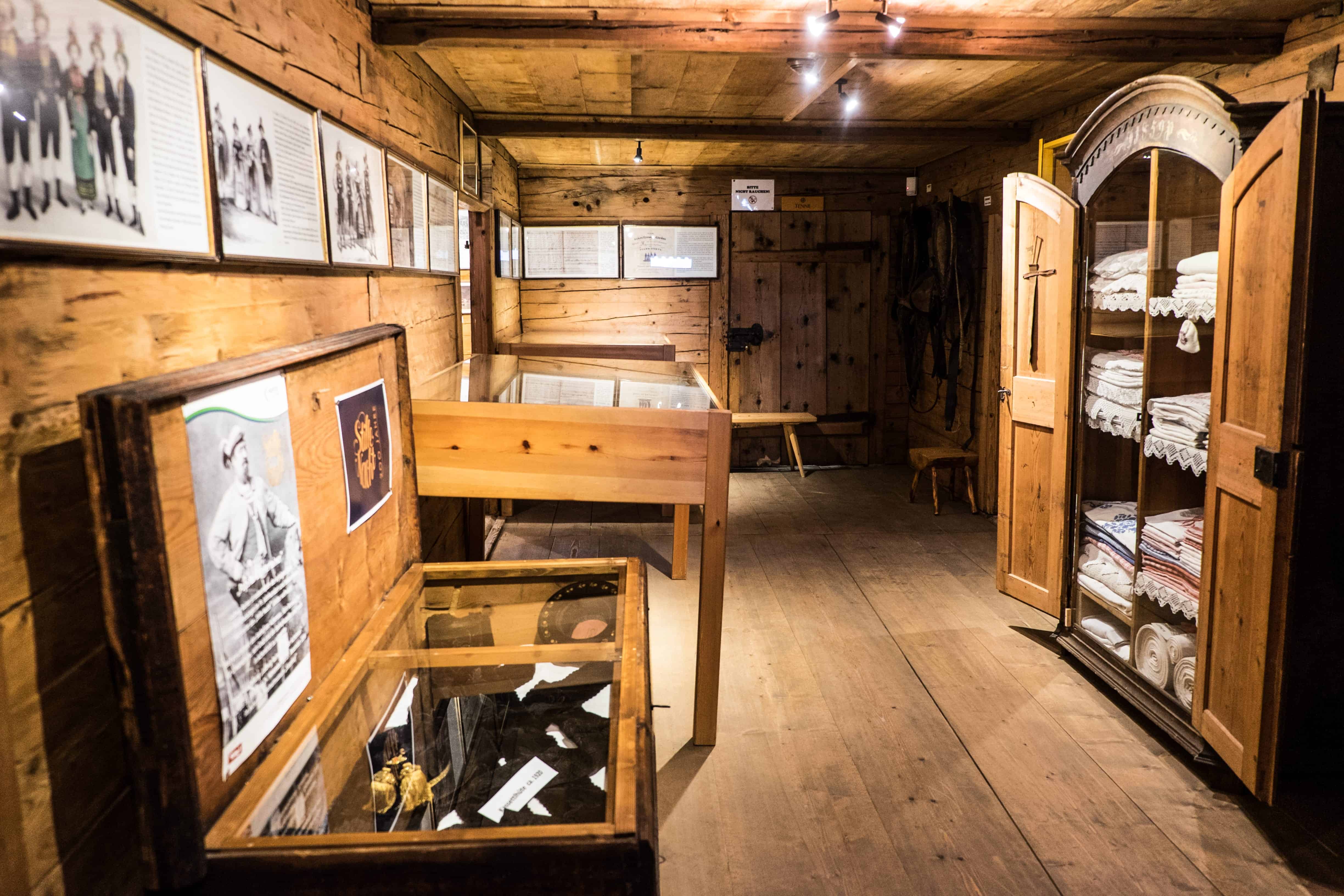
A step back in time inside Sixenhof Museum.
Travelling Europe and Russia until 1869, Ludwig Rainer returned home and later became an innkeeper in Tyrol, organising regular concerts at his Hotel Seehof in the village of Archenkirch, Achensee. The hotel no longer stands, but he is forever known not just as an entertainer, but a pioneer of Tirol tourism, whereby making it possible for singers to perform at home.
However, the Seehofkapelle (Seehof Chapel), which he had built next to the hotel, still stands opposite the lake ship station.
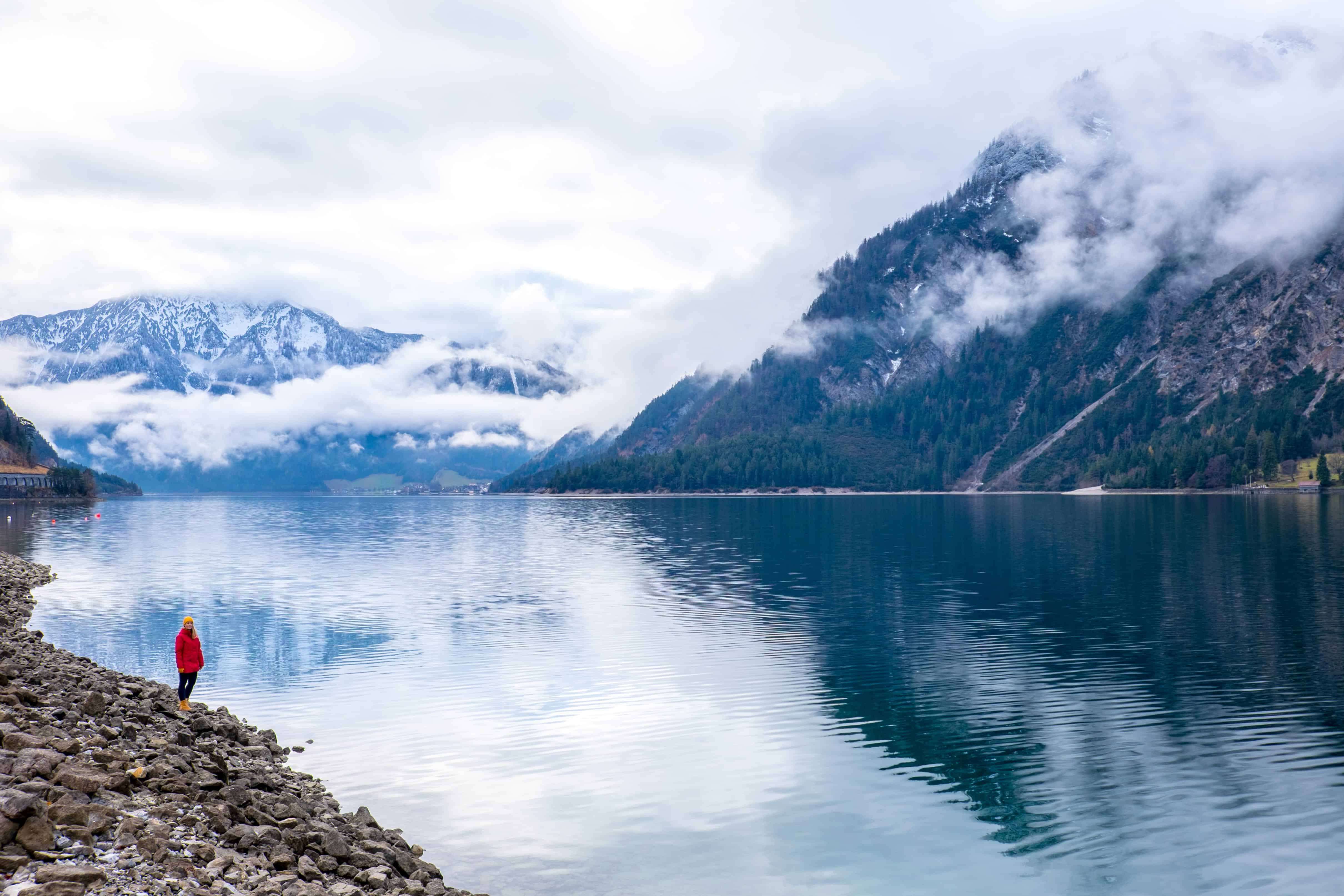
Lake Achensee in Winter.
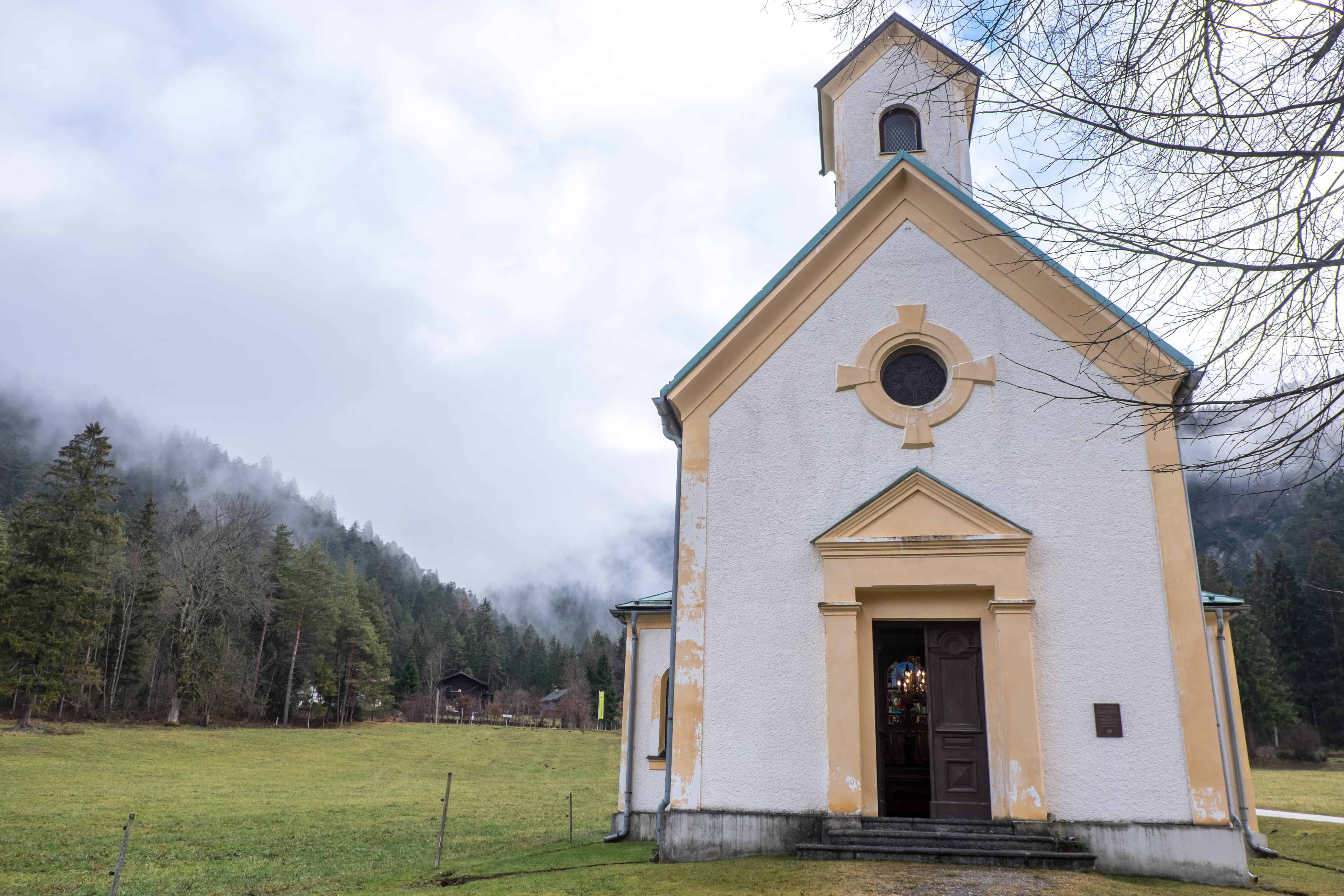
Seehofkapelle Seehof Chapel in Achensee, Tirol.
Silent Night is the most popular Christmas Carol, one of the best-known songs and quite possibly the song that is the most well-travelled and dispersed throughout the world. While you can journey on a location trail across Austria, its message of peace is everlasting, and its meaning is just as special today as it ever was.
A message many people will be reverberating this Christmas Eve as it echoes from homes, churches and streets on every corner of the planet.
Silent Night Story Snapshot
- Visit Salzburg at Christmas and learn more about the Silent Night song. This website provides specific information about events and locations in the city and the wider SalzburgerLand region.
- More information on the city of Steyr during advent can be found here, with details of the Christkindl region and the Pilgrimage Trail. For further details about travel in the region on Upper Austria, start here.
- For a list of things to do in the advent season in Tirol, related to the story of Silent Night, start here to plan your journey in the musical valleys.


Leave a Reply